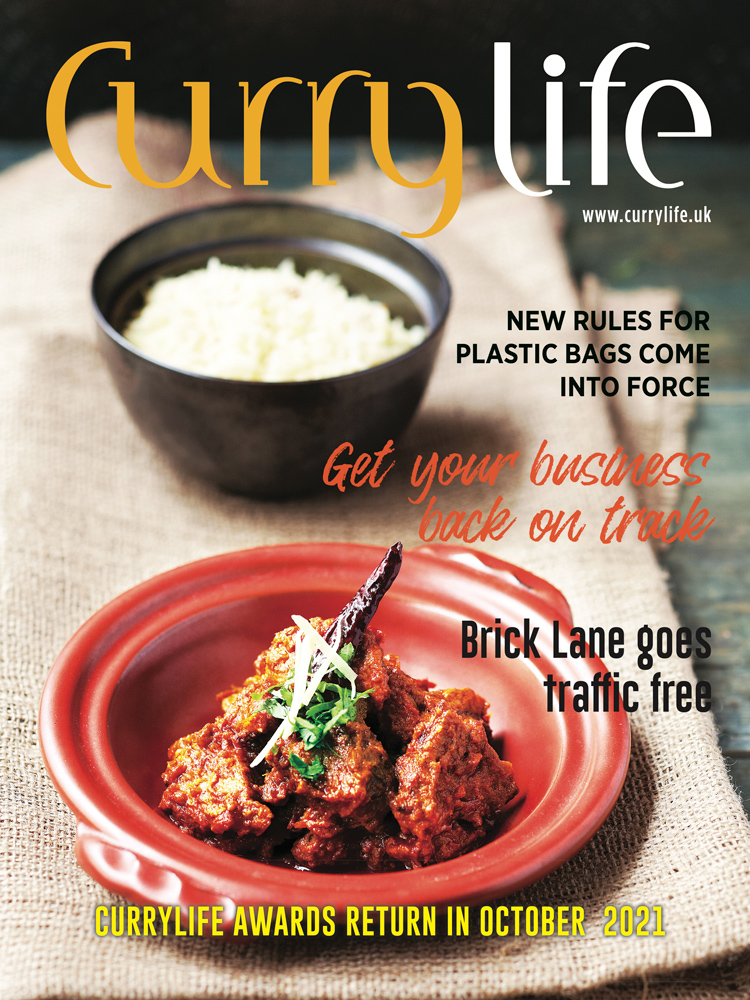
By the Water’s Edge
CURRY LIFE’S reporter Sam Smith caught up with Jangir Alam, proprietor of the stunning waterside restaurant Bombay Quay in the town of Northwich, to share his views on opening and running a successful large restaurant – and how to sustain one during a time of national crisis.
THE TOWN OF NORTHWICH is south of Warrington, which just so happens to feature Bombay Quay’s sister restaurant, Bombay 8. That restaurant featured in a previous issue of Curry Life from last year. The River Weaver runs directly through the centre of the town, making Northwich an ideal location to relax by the water’s edge and enjoy a good meal – especially now that the UK hospitality industry is coming out of hibernation.
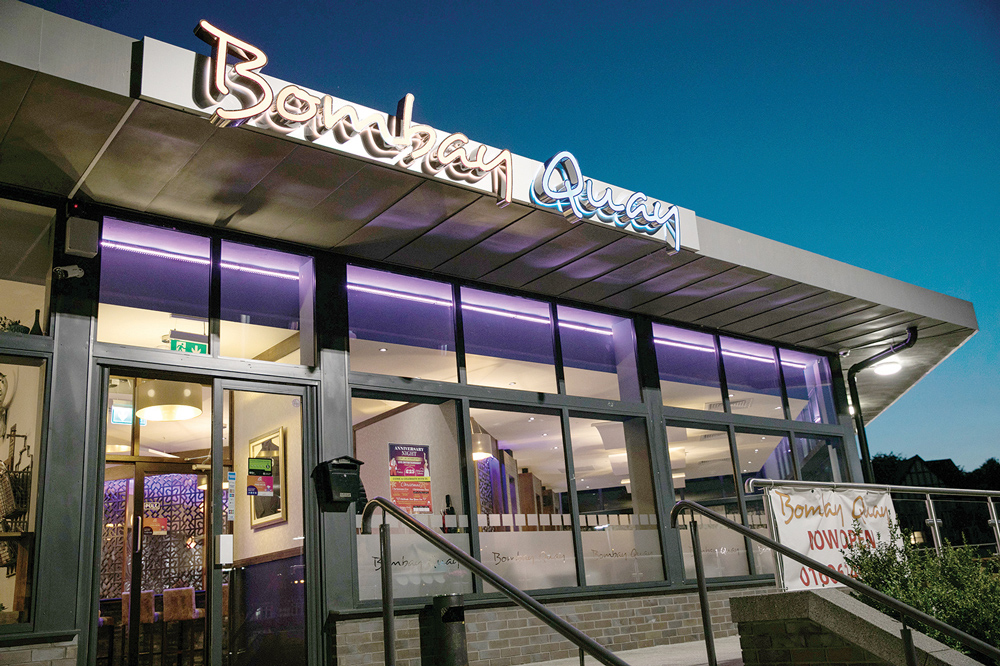
Alam believes Northwich is becoming increasingly cosmopolitan and that more people are settling in the town, so there is a demand for new and exciting places to visit and eat at. He points out a trend for fewer people leaving in the evening to go to nearby town centres; instead, they choose to stay in Northwich. All of which bodes well for his restaurant.
“More people have moved to the town, and more houses have been developed in recent years,” he says. “This has resulted in more restaurants too. We identified this trend and chose the town as our location for this reason. We named it Bombay Quay due to it being by the water and to connect to Bombay 8. We’re glad we did because our customers love it, there’s also nothing else like us nearby, so it was a worthwhile investment.”
Team approach
The restaurant opened in 2016 and around 80% of its customers are regulars, who bring new people who then return themselves and bring their friends.
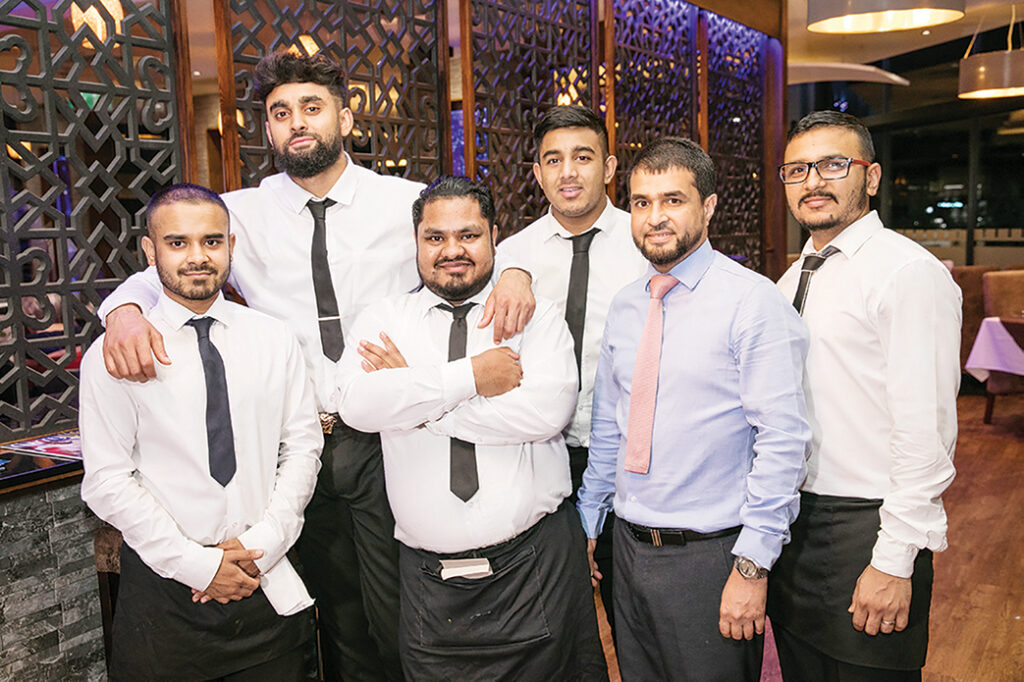
“We’ve done no traditional advertising since we’ve been open, with our popularity all about word of mouth. Our growth is down solely to our customers’ experience,” says Alam. “We have 12 chefs in the kitchen, most of whom have been here since day one. This has been great for consistency; our customers know what they like and what to expect each time they visit.”
One of Alam’s business partners from the front of house side has been stuck in Bangladesh since the pandemic started, however, leaving him and the other partners short-handed. The team has stayed in touch and continued to support one another, with everyone aiming to keep the restaurant operating at peak performance, even if they are separated for a period of time.
“It’s helpful to have a partner in each area of the restaurant, be it front of house or kitchen,” says Alam. “Each of us can then keep an eye on a different aspect of the business and take responsibility for it, and we all have a vested interest in its success. Other partners also know that the remaining areas of the restaurant are in good hands. We all want to succeed together. This method also helps us lead our individual teams from the front. You’re never taking instructions from a manager, but from one of the owners.”
Seizing opportunities
Alam himself started working in the restaurant trade at 14 years of age and gathered experience throughout school and college. He went on to study computer engineering at university, but upon leaving higher education, he decided to go back into hospitality, opening his first restaurant at the age of 21.
“My heart was in my course, I’m still very interested in technology, but I was always making five-year plans in my head, and opening a business was part of that”, he explains. “I think I was just more of an entrepreneur at heart. I have used these skills to improve the business though, be it through new digital innovations or software; I still love computers.”
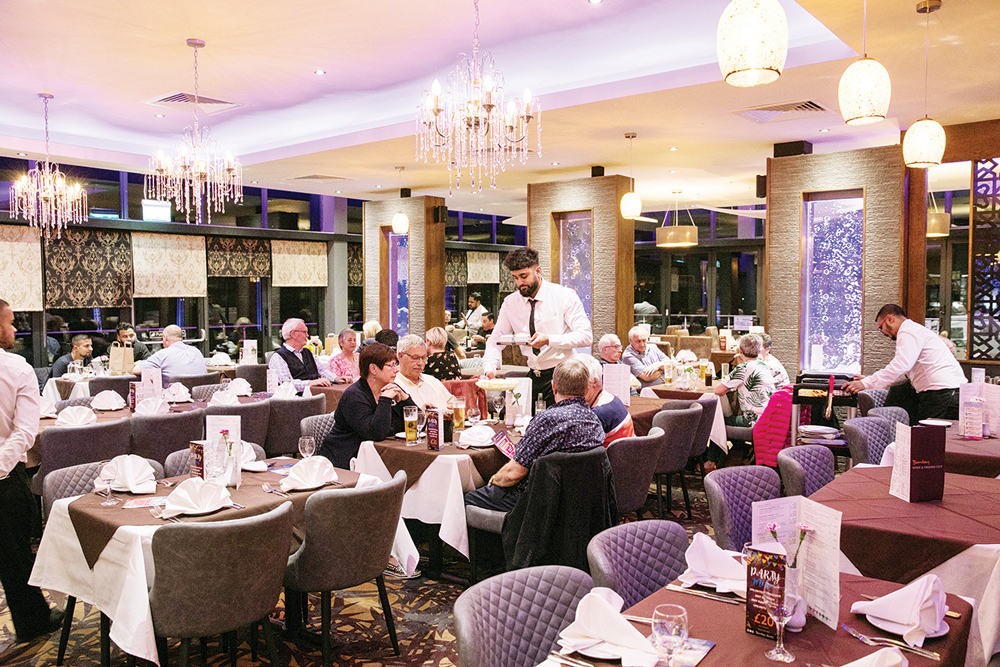
Running a restaurant during the Covid-19 pandemic presented a fair number of challenges, with everyone having to adapt to change.
“When the pandemic struck, we had 400 people coming in for Mother’s Day 2020,” recalls Alam. “I was driving to work listening to the news, and by the time I arrived, I started getting call after call asking to cancel reservations. This was just a few days before the first lockdown started.”
“We closed for a while just to gather our thoughts and make plans. Staff were asking what was going on, and for a while I didn’t know what to tell them. As their boss I needed to reassure them, but I didn’t know what was going to happen myself. Everything was so uncertain, and at first we only thought this was going to go on for a few weeks.”
Alam recalls leaving the restaurant the day it had to close. He says that as he put that key in the lock, he felt quite emotional, and he had no idea when he would be turning this key again.
“Or would I be passing the keys to someone else?,” he says. “It was an indescribable feeling, especially when you’ve worked so hard to build a business. I never thought I’d see the day when I’d need to close this place down. It was good to spend some time at home with the family when it all started, but in the back of my mind I needed to work out what was happening with the business.”
Changing times
When the business reopened, Alam decided this would be for only five days a week instead of seven, and with a minimal number of staff, who all worked together to share shifts to make sure that everyone got to be involved in some way. They liaised over Zoom and WhatsApp groups,with the team taking over responsibility for the rota. Alam says the partners were really impressed by how the team pulled together.
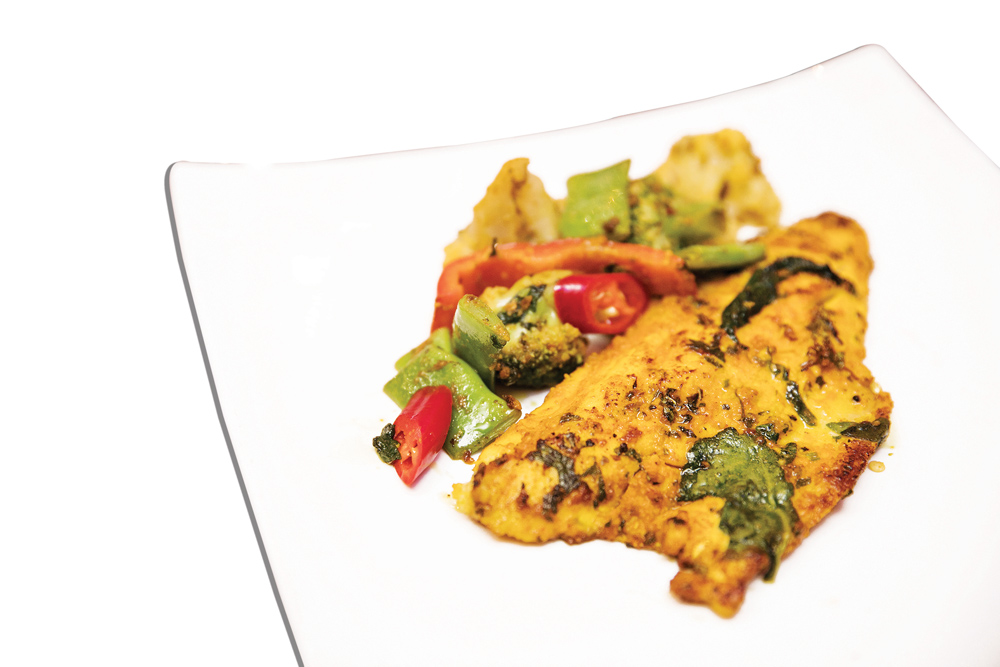
Once Bombay Quay reopened, Alam and the team had to work within the restrictions but also needed to ensure that as a business, it remained profitable.
“We’ve never done delivery, and have focused our efforts on takeaway only,” he says. “Once we opened, I was overwhelmed by the response from our regular customers. We created a one-way system for people to collect their food. People were queuing out into the car park and close to the street. We’d never seen anything like it before.”
To cope with the demand, the restaurant also had to turn off the phones and take orders in stages; this was to prevent the kitchen staff from being overwhelmed.
“Everyone liked the idea of enjoying a curry while things were so uncertain in the world, that may explain the demand. But this is when we realised we could get through this,” he says. “One challenge was paying the rent for the site. We have a fifteen-year lease here, and we did fall behind for a time. But I’m proud to say we’re totally debt-free now. We managed to open this May for table service with a clean slate, ready to start again.”
Keep your customers front of mind
So what advice would Alam give on running a restaurant during a time of crisis? Bombay Quay chose not to participate in the Government Eat Out to Help Out scheme, where diners received a 50% discount on food or non-alcoholic drinks when at a restaurant (up to a maximum of £10 discount per diner), every Monday, Tuesday and Wednesday between 3 and 31 August 2020.
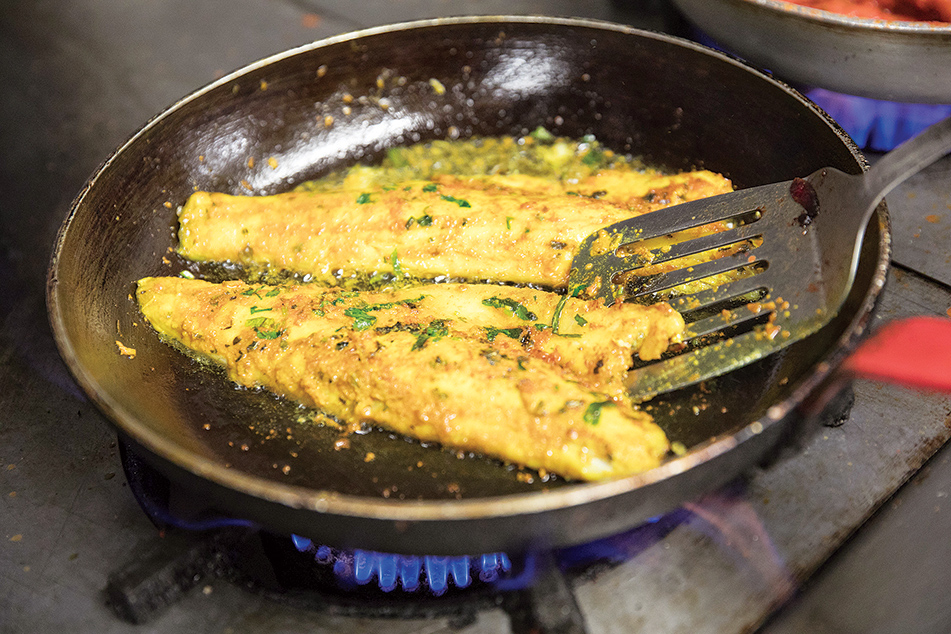
“We understood and appreciated the support from the government, but in my mind, we had already had that and Eat Out to Help Out risked alienating our regulars,” explains Alam. “We knew the restaurant would fill up anyway, but it would fill up with local customers who were just happy to be back. If we had done this half-price scheme, the restaurant would have filled up with new customers looking for a discount, and our regulars may have struggled to get a table. We’d rather make sure our regulars know they are always welcome.”
Bombay Quay didn’t limit its menu either and continued to serve its full range of dishes. While supplier costs did indeed increase during the pandemic, the Bombay Quay team didn’t feel the need to stop cooking anything from their menu. Alam organised his kitchen to make sure all dishes were available and could be cooked without difficulty.
“Chicken Tikka Masala has remained our most popular dish, but on top of that our house specials are also very popular,” he says. “In fact, we have a new dish on the menu, our Desi Lamb. This has a story behind it. At home I have meat on the bone and our chefs were making this lamb on the bone curry for our staff after their shifts ended.”
“It just had so much flavour, so I thought, why not add this to the menu?,” he explains. “The issue was these curries take a lot of time to prepare. So, we decided to cook it the day before and let the flavours really marinate overnight. This is now one of our most popular house specials.”
The dish is described on the menu as ‘This is what the boys eat!’. We tried this dish during our visit and were blown away by the flavours. The meat on the bone really did add another layer of taste. And despite the playful warning about how spicy the dish was in the description, we felt it had just enough heat to be enjoyed by any palate.
For Alam, there is one standout factor that helped Bombay Quay survive the pandemic, which he says applies to running a successful restaurant during any period of hardship.
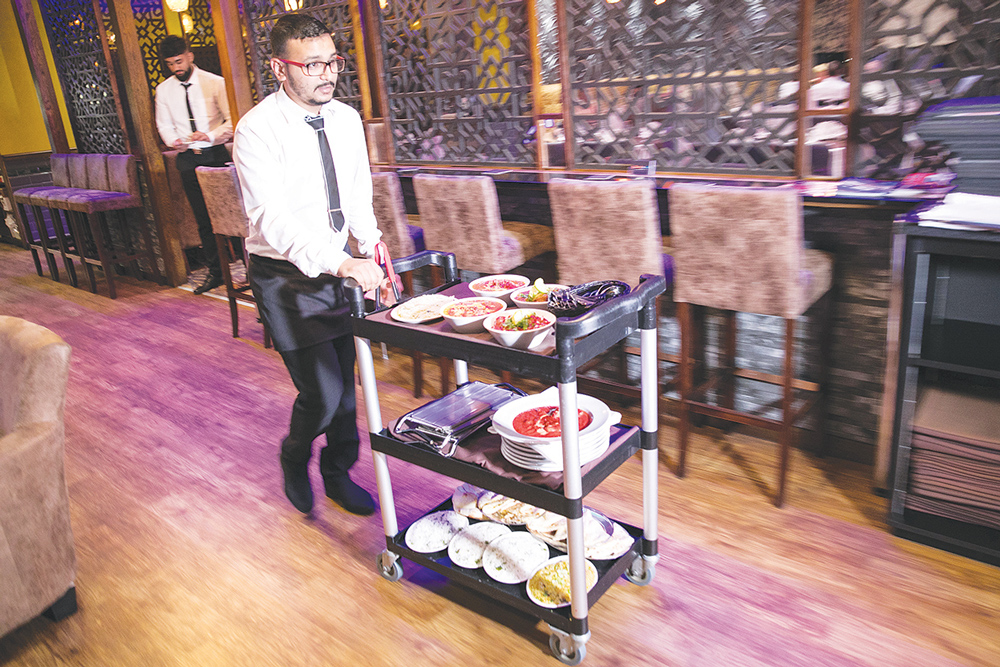
“I couldn’t have made it through without my staff,” he says. “Of course, you need to treat customers like they are a guest in your own home – at the end of the day, without them you don’t have a restaurant. But you also won’t have a business without your staff. I’m so thankful for my team, everyone was there for each other, and now we’re like a family. I would credit our survival and success to our staff.”
Alam is very much aware of the continuing need for the pandemic to be under control but he is looking to the future and making tentative plans for the coming months. He hopes to give back to the restaurant’s customers in some way and is also looking forward to planning a special celebration to tie in with the restaurant’s fifth birthday in October 2021.
Bombay Quay, Hayhurst quay, London Road, Northwich CW9 5EU
Tel: 01606 249911
Read more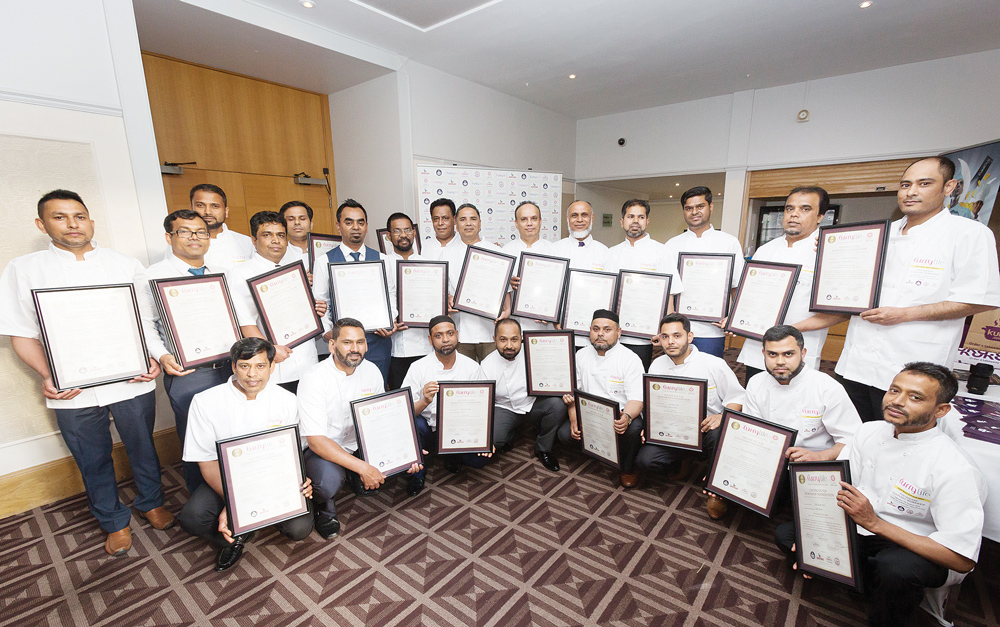
Get your business back on track
Curry Life is hosting its Culinary Workshop on the 25th July at the Crowne Plaza London Docklands. Presented together with experts from the hospitality industry, it promises to be an event packed full of insight into future trends and advice on how the curry industry can recover post-pandemic.
The evening will include a drinks and canapés reception, with plenty of opportunity for networking. This will be followed by talks and presentations from industry experts and suppliers, live cooking demonstrations and a gala dinner. In our event preview, speakers highlight their experiences from the last year and how they have kept positive, offer a taster of their presentations and share advice on kick-starting the curry industry.
The power of spice
Acclaimed food writer and celebrity chef Mridula Baljekar will be highlighting the health benefits of everyday spices. She is passionate about healthy eating and says Indian food is ideal for a healthy diet.
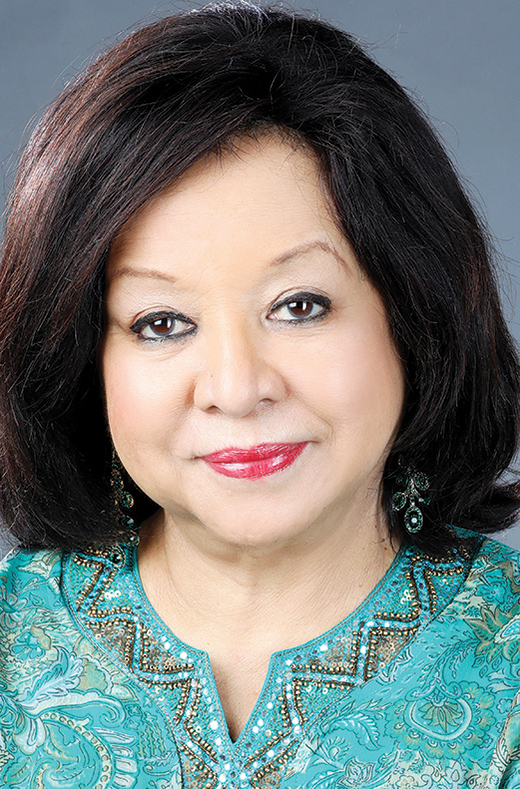
“Spices have healing properties which many people are unaware of,” she says. Everyday spices such as turmeric have been used in India for thousands of years to cure arthritis, boost the body’s immunity levels, fight heart and brain diseases and many more ailments. Chinese herbalists called turmeric a ‘healing plant’. Other spices we use daily are garlic, ginger, chilli and onion, all of which contribute to a healthy lifestyle”.
Baljekar’s next book, due to be published in 2022, is called Spice Secrets; A Doorway to the Magical World of Spices. It features the health benefits of spices and their origin, a guide to buying and storing and easy-to-follow recipes.
As well as writing her book, Baljekar has been busy in the last year adapting her business in light of the pandemic. With her cookery classes and live cooking demonstrations cancelled during Covid-19 restrictions, Baljekar looked to replace some of the lost income, while also helping those who love Indian food, but who could not visit their favourite restaurants.
“I developed a range of Indian ready meals and launched them in food stores near my home in Windsor and I am hoping to take my meals to a wider market in the near future,” she says.
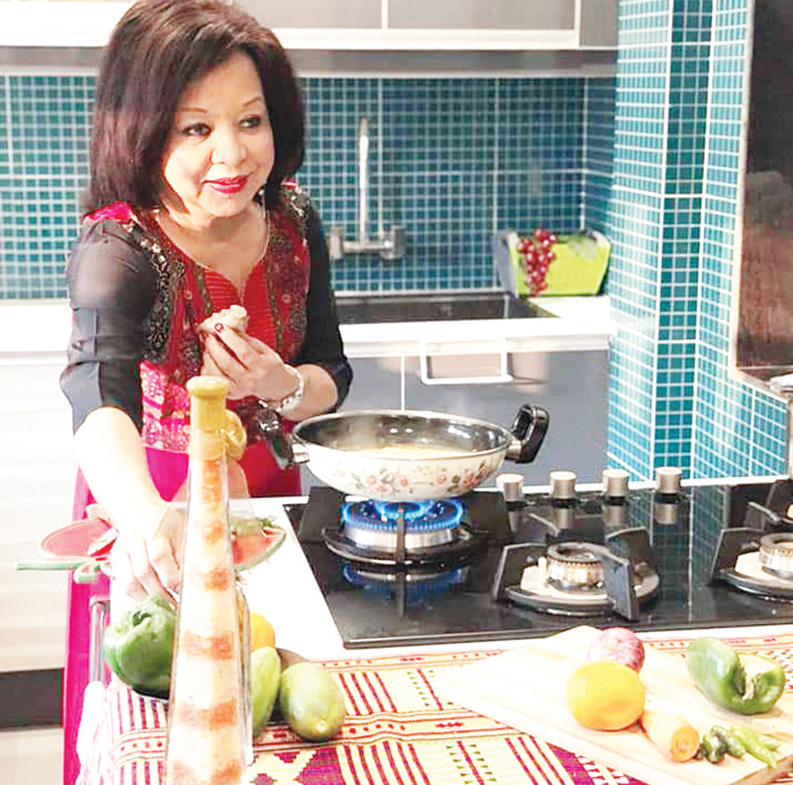
She also launched online cookery classes for those looking to build on their home cooking skills, attracting budding cooks from the UK alongside Europe and the US. “Making people happy through my food has always been very dear to my heart and I am thrilled that I have been able to do that even during the pandemic,” she says.”Promoting Indian food and the industry has been my focus for many years. Indian food is vast and varied and it is the spices that unite this vastness.”
Baljekar believes that it is time for the curry industry to re-think how it cooks and presents food, bearing in mind the enormous doubts and fears that the pandemic has created in everyone’s minds.
“Clean tasting and healthy dishes with clear and precise descriptions on the menu, highlighting the health benefits of the dishes, could be one way to instil confidence in people,” she says. “Avoiding too much salt, sugar, oil, butter and ghee will be my way of cooking; it is not necessary to use excessive amounts of these ingredients to produce delicious food.”
Baljekar says the future of the curry industry can be as good – if not better than it was pre-Covid, but there are certain challenges the industry needs to overcome.
“We need to ensure that restaurateurs are not crippled by high rents and business rates – both landlords and local authorities hopefully will look at these issues more sympathetically,” she says. “Industry suppliers have also suffered during the pandemic; hence sourcing local produce could be another way to gain customer confidence and help suppliers. Needless to say, eating local will also reduce carbon footprint, which in turn will contribute to a cleaner planet.”
Staying positive, says Baljekar, is the key to success in life, but when adversity hits us, it is easy to fall into a negative mindset.
“Faith and hope are the only things that can help us to hold on to positive thinking. Bad times don’t last forever, just as good times do not,” she says. “My own thinking is ‘have faith in yourself and your work and never give up hope’; this has helped me to overcome hard times and enjoy sunny days.”
Refocus and recharge
Mark Poynton, chef patron of MJP@TheShepherds in Fen Ditton, located close to Cambridge and former head chef at Michelin-starred Alimentum, will also be speaking at the workshop. In the last year, as well as refining recipes for his restaurant, he has been busy working on a debut cookbook, due out in autumn this year, featuring a range of his signature recipes. His current menu showcases dishes such as tandoori roast cauliflower, cumin dhal, pomegranate; smoked pork belly, snails, focaccia and stone bass, turnip, pistachio, mustard.
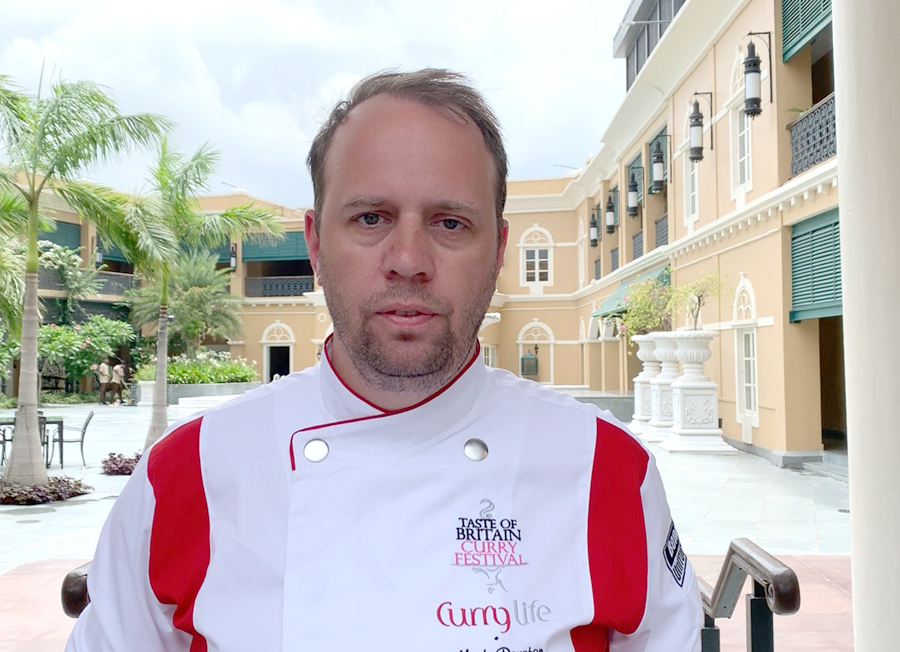
“My main challenge in the last year has been making sure we can stay afloat and have a business to come back to,” he says. “We flipped to ‘at home boxes’ at a very early stage and that has been a massive help, both business-wise and to keep the team motivated. The Government has also been fantastic with grants and the furlough scheme.”
Poynton has kept himself motivated by thinking of his team and his family, and pushing every day to be better than yesterday. In the near future, he says he is looking forward to hosting ‘a full restaurant, seeing people cook recipes from my book and who knows, possibly a second MJP.’
For the curry – and other food industries to recover, Poynton believes it’s important to refocus and look at streamlining the business. “Think about whether you need to open seven days – at MJP we are only open three and a half days a week as it is better to be full on those days rather than half-empty across seven,” he says. “It means less staff are needed and you can use the same staff everyday for consistency, so there is less waste, less mistakes and fundamentally happy customers.”
Getting back to basics and looking at education and staff welfare is one avenue Poynton says could be further explored. “Has anybody ever looked at opening a purely Indian-styled catering and hospitality college in the UK? We have to forget that we can no longer hire from abroad and think outside the box,” he says.
A sustainable approach
Sustainability and how to buy products wisely will be the main focus of Dominic Chapman’s workshop session. The chef/patron at country restaurant/pub The Beehive in White Waltham, says that in the wake of the pandemic, sustainability and looking after the planet are important issues for the restaurant industry.
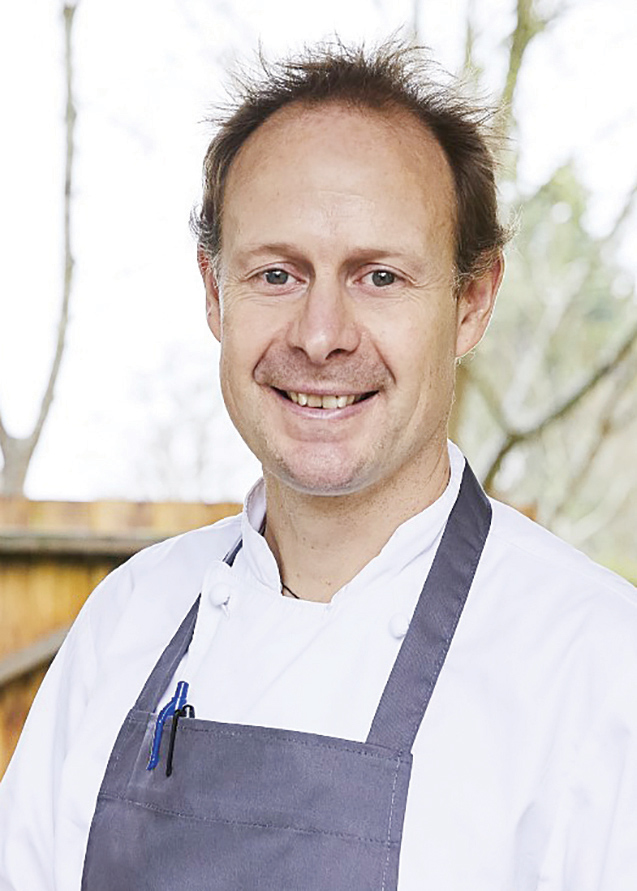
“Try not to use unsustainable produce; if you spend a little more to get a better product, you get happier customers,” he says. “Buying sustainably is going to benefit you more. At The Beehive, we focus on sustainable, seasonal food. We buy day boat fish, source locally-grown produce and opt for free range, all of which can reduce air miles.”
Like others in the industry, Chapman focused on takeaways during the pandemic but also adapted in other ways to manage cashflow, offering goods such as toilet rolls, cornflakes and bin bags.
“If we could get it from our suppliers we sold it, I was supplying all the things you couldn’t get in the supermarket such as flour and eggs,” he explains. “We adapted very quickly and we found our rhythm to create ready meals – ‘Beehive dinners at home’.”
This included a range of takeaway dinners, such as fish and chips, burgers, burritos and kebabs. Chapman also promoted the dishes on social media, with the aim of creating community spirit and reaching as many people – local and further afield, as possible.
He believes the curry industry is a leader in the takeaway sector and hopes that this side continues to flourish. But with Indian restaurants facing so much competition, Chapman believes the key to survival and recovery will be focusing on using good quality ingredients and sustainable produce. And with many Indian restaurants providing a large menu, Chapman believes they have to provide the quality to match the sheer size of what’s on offer.
“Indian restaurants are very entrepreneurial businesses – as long as they focus on the quality of food and service they will bounce back,” he says. “Sustainable food does not have to be expensive; if you have good ingredients and offer wonderful service, you will have the makings of a good restaurant.”
Keeping busy has helped Chapman to maintain a positive outlook in a tough year. As well as having reopened The Beehive in line with Government rules, he is continuing the takeaway and delivery operations that were started during the pandemic.
“We will see how this goes and if we need to employ more people we will get creative and think on our feet,” he says.
Adapt to changing behaviour
Mo Gherras has more than 20 years experience in the restaurant trade and opened his new venture – The Cross Keys pub in Sherborne in June 2019, less than a year before the Covid-19 pandemic hit. The business remained open from the very first UK lockdown, with Gherras changing and adapting the model on a regular basis, adjusting to customers’ needs.
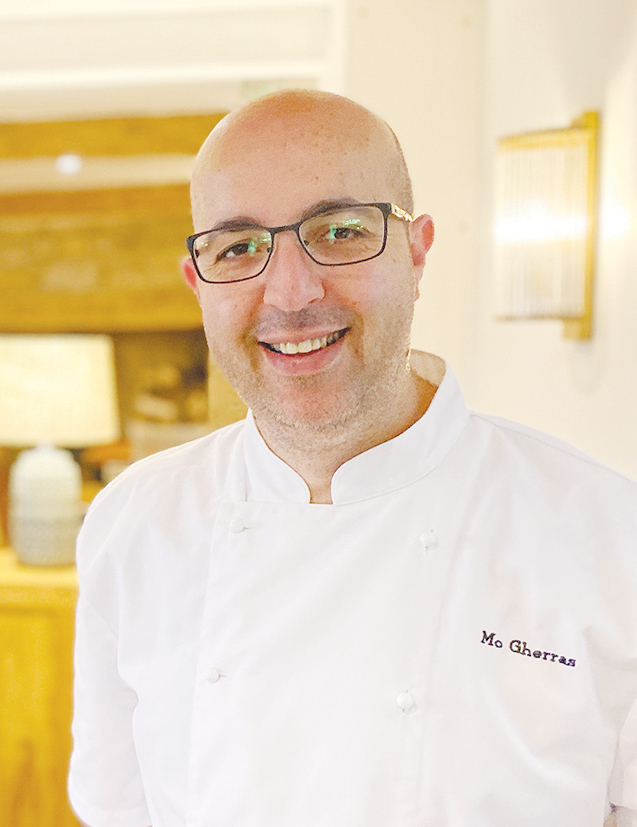
“We are very much part of the community, doing food deliveries and changing our menus to suit customers’ tastes, “ he explains. “For example, on Friday we do fish and chips – this is one example of the classic dishes that people want.”
During the third lockdown, Gherras turned the pub into a shop, establishing a community hub, serving breakfast and providing essential supplies. He says such a business model means they can quickly adapt to customers’ changing needs.
His efforts thus far have paid off, with The Cross Keys being recognised with a number of awards. It was the winner in the New Business of the Year category at the Dorset Tourism Awards 2020 and also won Silver in the ‘Pub of the Year’ award. It was also named a ‘Great Days Winner’ by South West Trains; this accolade was given to five small businesses, with each receiving a recovery package worth £12,000. Gherras says upselling customer demand put the restaurant on the map beyond Sherborne. The package was used to help with marketing, with the restaurant featuring on billboards on 20 stations from Waterloo to Exeter, as well as investment for new equipment.
Gherras believes curry restaurants are adapting to people’s changing behaviours, particularly with regards to deliveries.
“The mindset with delivery has changed – previously it was seen as a treat now it is a necessity,”he says. “That is how you get your name and brand out there, doing door-to-door deliveries yourself, not through a third party. If you make an effort, locals will support you and this is particularly true for Indian restaurants. There is a lot of competition out there.”
He sees staffing as the biggest issue, not just for Indian restaurants but for the entire hospitality sector, with a shortage of chefs one of the main challenges.
“Furlough in part has created this, with many people only choosing to work a couple of shifts here and there, without any pressure to do more,” he says.
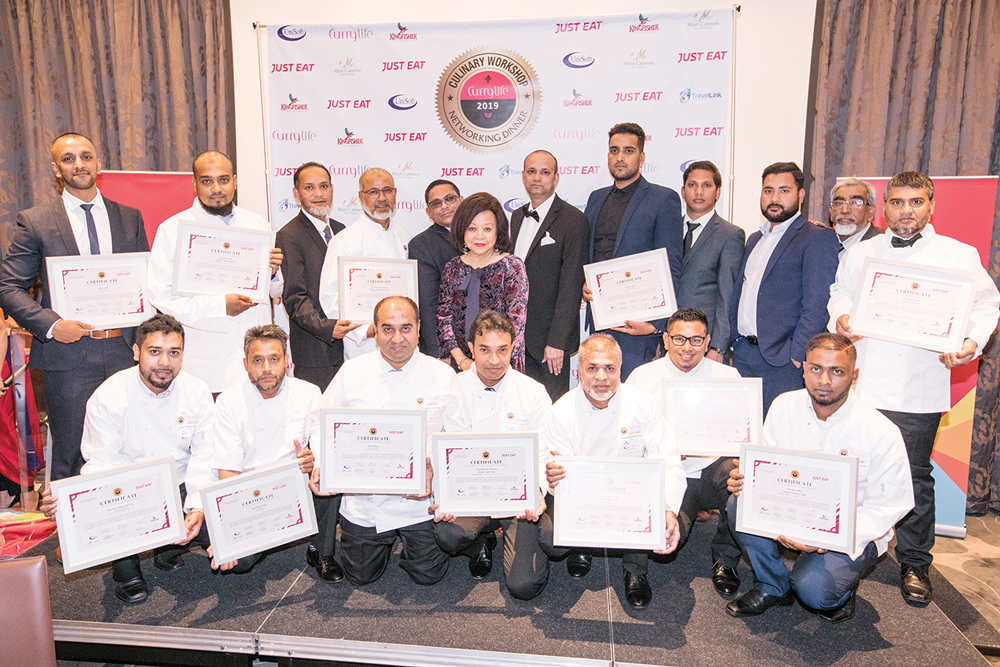
To register for the Curry Life Culinary Workshop
Curry Life Culinary Workshop and Networking Dinner is taking place on SUNDAY 25th July 2021 FROM 4PM TO 10PM, at the Crowne Plaza London Docklands, Royal Victoria Dock, Western Gateway, London E16 1AL.
Participating chefs and restaurants will receive a certificate for attending the culinary workshop and panel session. The headline sponsor for the event is JUST EAT, with additional event partners including Unisoft Solutions, CLCC and Travel Links Worldwide.
Those interested in attending this event must reserve tickets in advance.
To reserve your space at the event Call 07956 588 777 or send a text.
Read more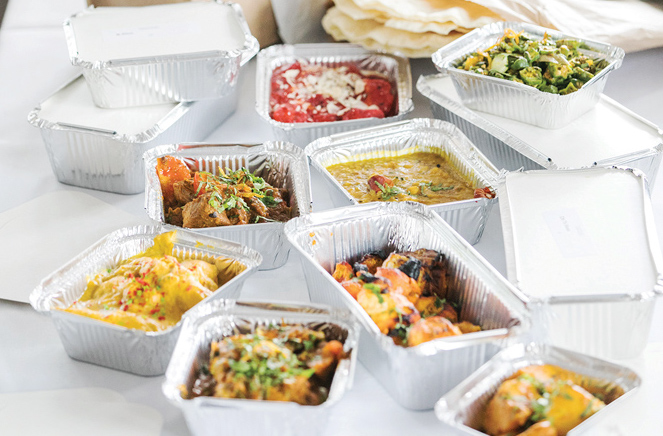
Takeaway tips: Capturing that restaurant feel
DESPITE TABLE SERVICE (finally) returning to the UK hospitality industry, takeaway meals will continue to be important for a long time to come. Many curry lovers in the UK order a takeaway instead of going for a sit-down meal, so getting the takeaway right is always important.
We’d be naive to assume that everyone in the country will rush back to restaurants now that they are open. There’s still a lot of trepidation around the country, with many people waiting to see what happens before they go out and eat within a restaurant setting.
Habits will have changed forever, and normality may still be a long way off. Therefore, takeaway meals are likely to still be an essential part of any restaurant’s business model going forward.
The question is, what can businesses do to make their takeaway meals replicate that restaurant quality feel? While the food is often similar, there is usually a difference between restaurant quality and what you might get as a takeaway; here are a few ways to bridge that gap.
Perception makes all the difference
It all starts with a restaurant’s perception of takeaway food and their attitude towards it. If a restaurant treats their takeaway dishes with the same attention they devote to sit-down meals, this will become apparent to the customer. It communicates to them that all food from the restaurant is of the same standard. It demonstrates that takeaway customers are just as valued as those who visit for a sit-down meal.
If however, the restaurant views takeaway meals as less important, then this too could be reflected in the food and the customers may pick up on this. As a result, those customers may choose to avoid that restaurant. If they didn’t enjoy their takeaway, they’ll be unlikely to ever visit for a sit-down meal, fearing a similar experience. This is why takeaway food needs to be considered just as important as any sit-down meal.
Taste and quality is key
It’s important that any food cooked for takeaway meals is of the same quality as the dishes served in the restaurant. Customers who frequently visit for a sit-down meal will be able to tell the difference if this is not the case.
Customers who order a takeaway are likely paying the same as those who enjoy a sit-down meal, so they must receive the same attention to detail when it comes to food preparation. Ensure the same ingredients are used regardless of whether it’s a takeaway or restaurant dining.
Essentially, don’t cut corners when it comes to food cooked solely for takeaway; treat every meal like it was going out of the kitchen and onto someone’s table. The only difference between the two is that the table in question just happens to be in a different building.
Pay attention to presentation
The presentation of a takeaway is never going to be able to match that of a sit-down meal. A takeaway is a very different experience, and while it can match a sit-down meal in terms of taste and quality, aesthetics is a whole other matter. The good news is customers don’t expect a takeaway to resemble the presentation of a meal served in-house. They are far more concerned with taste, quality and value.
However, that doesn’t mean a restaurant shouldn’t endeavour to make their takeaway meals resemble their sit-down dishes as much as possible. The more similar they appear in their presentation, the more customers will feel like they are eating a restaurant-quality meal. Presentation always counts for a lot when it comes to enjoying food, so this should always be considered.
If you can find ways for your takeaway dishes to be more aesthetically pleasing in their presentation, then customers will have a better experience. Remember, you sample food with your eyes before your tastebuds.
Consider your packaging
Packaging is heavily connected to presentation, but rather than serving your takeaway food in the standard aluminium containers with card lids, try to investigate other forms of packaging. Restaurants which pride themselves on healthy dishes should consider more sustainable packaging; not only is this good for the environment, but it will also win the hearts of customers who care about these issues.
By investing in new forms of packaging, you can also arrange your food to match your on-plate presentation more closely. This allows you to deliver and serve your food in a way that reflects your sit-down dining experience, rather than the typical takeaway presentation. It may be a small detail, but it counts for a lot when it comes to takeaways capturing that restaurant feel.
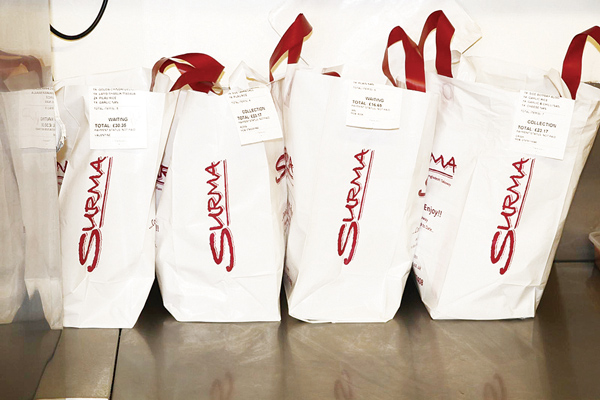
The social factor
Many restaurants use social media and other forms of advertising to share delicious-looking pictures of their cooking. The images are usually of food cooked in the restaurant and reflect what a dish would look like when brought to your table. This is something every restaurant should do – and continue to do. But don’t forget to showcase snaps of your takeaway food too.
Have some professional pictures taken; this is because many of your customers will only be ordering food for takeaway, perhaps for the foreseeable future.
Marketing materials and images that simply show your food on a plate may not be enough to tempt a customer into ordering a takeaway. However, if your pictures of your takeaway meals look just as delicious as your plated ones, then seeds will be planted in the minds of your customers. This will make them far more likely to pick up the phone (or use an app) and order a takeaway from you.
Research and recharge
When the pandemic struck, and takeaways became the restaurant trade’s only lifeline, the curry industry was quick to adapt. Many restaurants already had a takeaway infrastructure in place, so they could pivot quickly and continue to earn a profit.
However, restaurants in the fine dining business across all cuisines were much slower at adopting this approach. In the eyes of some restaurants, takeaway was simply not something they’d consider. To them, serving food was a pageant, and the experience could not be replicated through takeaway.
Yet as the months went on, many fine dining establishments needed to change this policy – or they risked going out of business. In time, they developed some creative and novel ways to sell their food as a takeaway, but without compromising on their values or the experience.
Naturally, some concessions were made, but these restaurants made serving takeaway food into an art. They all did different things, but much of it had to do with presentation and artistic flair. Investigate what some of these restaurants did and see if you can apply it to your own takeaway meals.
Read more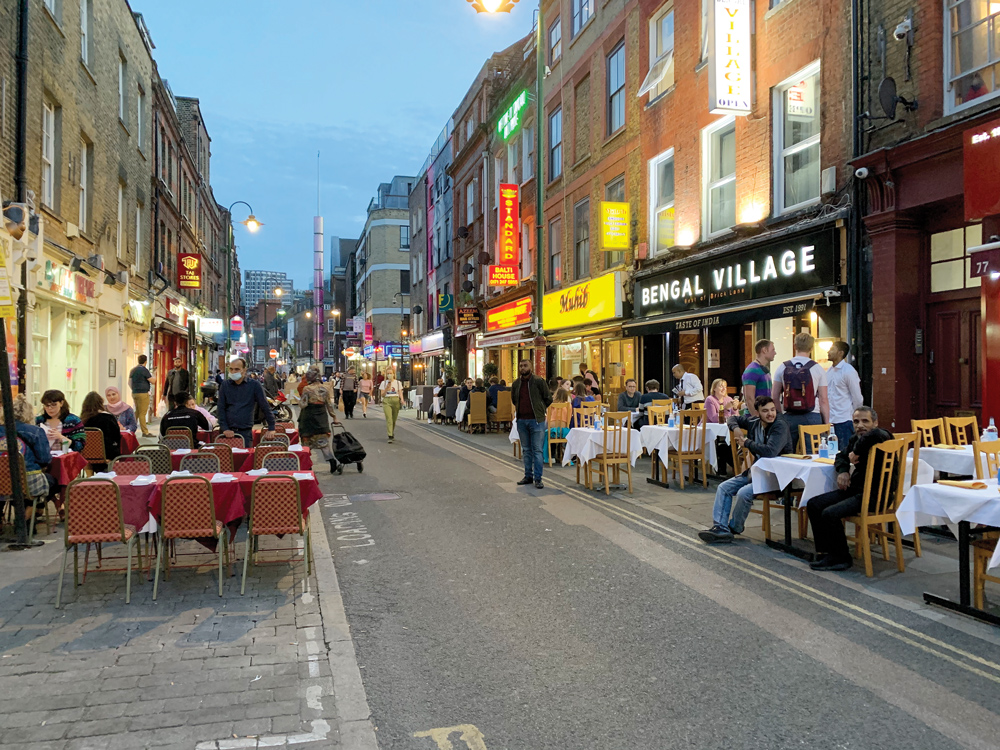
Council approves plans to make Brick Lane traffic-free
TOWER HAMLETS COUNCIL has approved plans to make sections of Brick Lane traffic-free on certain evenings and all weekend, as part of the council’s ‘Liveable Streets’ programme.
The plans were approved at the end of May at the Council’s Cabinet meeting, following a consultation process with residents, businesses, key groups and emergency services.
The changes will see the road closed to traffic on Thursday and Friday between 5.30-11pm and Saturday and Sunday from 11am-11pm. Proposals to restrict traffic at these times to support Brick Lane businesses and make the road safer, were supported by a majority of residents, visitors and Brick Lane businesses. The restrictions will be monitored by Automatic Number Plate Recognition (ANPR) cameras.
Detailed designs will be prepared with the first works set to start this summer in a phased manner to minimise disruption to residents and businesses.
The Council has previously said timed restrictions for motor vehicles would ensure businesses can continue to receive deliveries and collections during the day on weekdays. It says the timed closures will provide a safer environment for pedestrians during evenings and weekends and could support businesses to trade safely and make use of outside dining space.
Last year, parts of Brick Lane were temporarily pedestrianised in the summer, to provide safe spacing for walking and social distancing and outdoor seating for restaurant customers. However, during this trial, there were 24/7 road closures and roads were blocked with planters to restrict access.
John Biggs, Mayor of Tower Hamlets, said: “Our Liveable Streets proposals will give a boost to Brick Lane by making it a safer, greener and cleaner place. Reducing traffic at peak times will help create a safer and much more enjoyable environment for everyone.

“The changes will help our local businesses bounce back from the effects of Covid-19 restrictions by being able to use more outdoor space and attracting more shoppers and visitors. We will of course monitor the impact and continue to work with those businesses and our residents so we can ensure this jewel in the crown of our borough thrives.”
Further measures, as part of the Liveable Streets scheme, include a School Street, which restricts traffic at drop off and pick up times on Underwood Road, Buxton Street and Hunton Street. Tower Hamlets says this will improve air quality and safety for children who attend these schools.
Deal Street will become one-way southbound between Underwood Road and Woodseer Street and 10 new cycle hangers will be installed in the area.
The Liveable Streets programme aims to improve the look and feel of public spaces in neighbourhoods across the borough and make it easier, safer and more convenient to get around by foot, bike and public transport.
According to information from Tower Hamlets, Brick Lane is an area of London that attracts over 18,500 pedestrians every day. This space is also shared with over 4,000 vehicles, many of which use Brick Lane to cut through the area. Tower Hamlets says they are not visiting local businesses, schools or places of worship but are significant contributors to the already unacceptable levels of air pollution and congestion along Brick Lane.
These proposals are a key part of Tower Hamlets commitment to support Brick Lane’s economic recovery from the Covid-19 pandemic and aims to attract more visitors to the area and support businesses to trade safely. In the consultation, the Councils said if the traffic management proposals for evening closures are supported, further discussion will take place with local residents and businesses as to whether these are still preferred in winter time, when the benefits of facilitating outdoor dining are much smaller.
Read more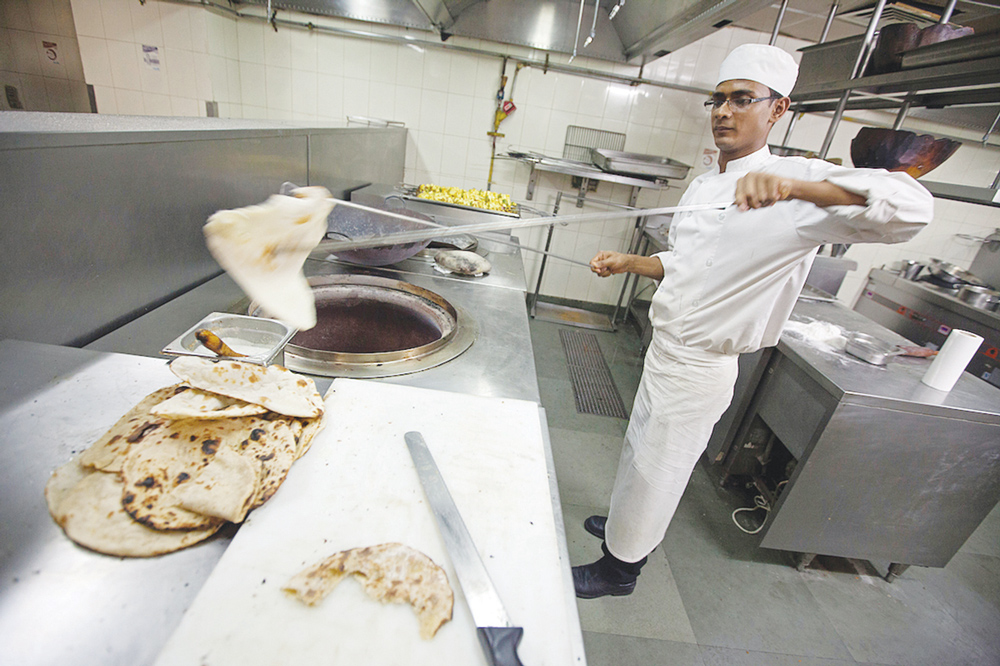
Staff shortages a growing concern for curry houses
INDIAN RESTAURANTS ARE struggling to reopen following the easing of lockdown restrictions as they do not have enough staff, with recruitment for skilled roles such as Tandoori chefs remaining a challenge.
Mohammed Atikur Rahman, owner manager of Watford-based Indian Sizzler says he is trying his best to keep the restaurant open for as many hours as he can.

“I might have to close at certain times as I don’t have enough staff to keep up with the number of customer orders,” he says. “Some staff were put on furlough during the lockdowns but they have since found other work and don’t want to come back.”
Rahman has advertised for staff on social media, via Facebook and through an agency but says the majority of applicants are wanting more money than he can afford to pay. As Rahman points out, his business too is recovering from months of closure owing to lockdown, and he cannot justify putting prices up to pay increased wages to staff. The effect of Brexit is also having an impact; previously Indian Sizzler employed staff from Eastern Europe, but Rahman says many Europeans have returned home, a combination of Brexit and the pandemic making it less attractive to stay in the UK.
The Derby Telegraph recently reported that the Marigold Indian in Tutbury did not reopen the week of the 17th May, when in-door dining resumed, as it could not find staff for positions including chefs, waiters and pot washers. The restaurant was closed throughout the various lockdowns, resulting in staff moving on to different roles.

Oli Khan MBE, senior vice president at the Bangladesh Caterers Association, says staff shortages have been a long-standing problem for curry houses. Tough immigration rules mean restaurants are unable to hire skilled chefs, while the curry sector is also suffering from succession issues. Many children are reluctant to follow in their parents’ footsteps and join the family business, pursuing other careers instead. The pandemic has made a bad situation even worse.
“The pandemic has certainly not helped – many staff were furloughed, but since a lot of restaurants don’t have contracts in place, when it’s time to come back, staff have moved on to other jobs,” says Khan. “Many Eastern Europeans who worked in curry houses have also gone back home or they are in alternative employment.”
Training colleges have previously been set up to encourage potential staff to learn new skills, but Khan says these are not a workable solution. “They closed because not enough people were signing up for the courses. It’s a real challenge to recruit skilled roles such as a chef, tandoori chef or sous chef,” he says. “More needs to be done to recruit staff from South East Asia, semi-skilled staff who could train here for three to four years to become a skilled chef.”
Last month, trade association UKHospitality released findings from its survey of hospitality workers, revealing the extent of the staffing crisis facing the hospitality sector. It said the shortage of front-of-house staff and chefs is particularly acute, with 80% of those surveyed reporting vacancies for front-of-house roles, such as waiting and bar staff, while 85% are in need of chefs. The survey suggests a current vacancy rate across the sector of 9% – which implies a shortage of 188,000 workers.
The survey also showed that for overseas workers, many of whom returned home at the beginning of the pandemic, travel restrictions were a primary reason they had chosen not to return to the UK. Nearly a fifth said the cost of quarantine on return was preventing them from coming back.
Read more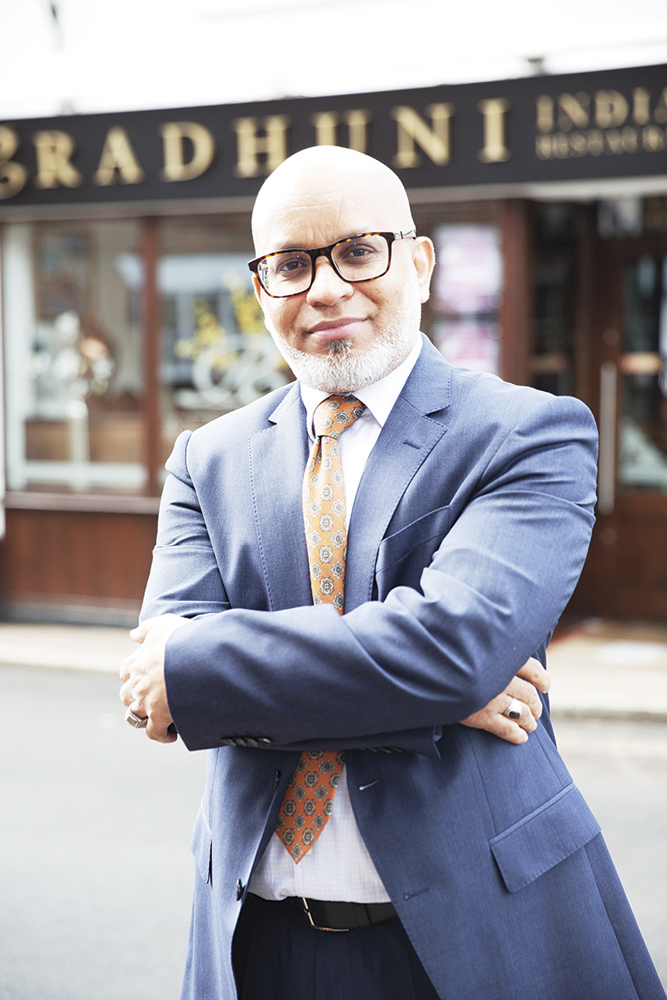
AIMING HIGH
Radhuni has gained a reputation for its unusual dishes and its location within a wealden house. Now the restaurant is setting its sights on expansion, as well as launching a new menu.

“This is not your average curry house.” At first glance, it’s a fitting description of Radhuni restaurant by its owner, Akthoraz Miah. It is housed in an atmospheric Grade-II listed building – a wealden house that dates back to the 16th century and which was once a former library, with impressive black and white timbering.
The restaurant is located in the market town of Princes Risborough, in Buckinghamshire, close to High Wycombe. It is one of three restaurants under the Radhuni brand (the other two are in Bedford and in neighbouring Flackwell Heath) and was established just under fifteen years ago, although Miah has been involved in the restaurant trade for more than 30 years. Originally from Bangladesh, he came to the UK in the mid-1980s, and started in the hospitality business by working in a takeaway restaurant in Manchester.
Radhuni has charm from the outset and is steeped in plenty of tradition. The interior features a cosy bar at the entrance decked in earthy, warm colours and decorated with ornaments, while the main dining room is striking, featuring high ceilings with oak beams, brass chandeliers and giant wheels on platforms above the tables. You’ll also find classic Indian fare on its menu, such as Madras, Korma and Jalfrezi curries. But there’s plenty of forward thinking, innovative cuisine too.
Element of surprise
Miah believes that offering customers something new, fresh and surprising will keep them coming back for more, and there are many regular customers who enjoy the restaurant’s unique take on dishes. Many of its diners are local and from further afield, with many customers visiting based on word-of-mouth. They also appreciate good food and presentation, with many of the dishes served plated-style.
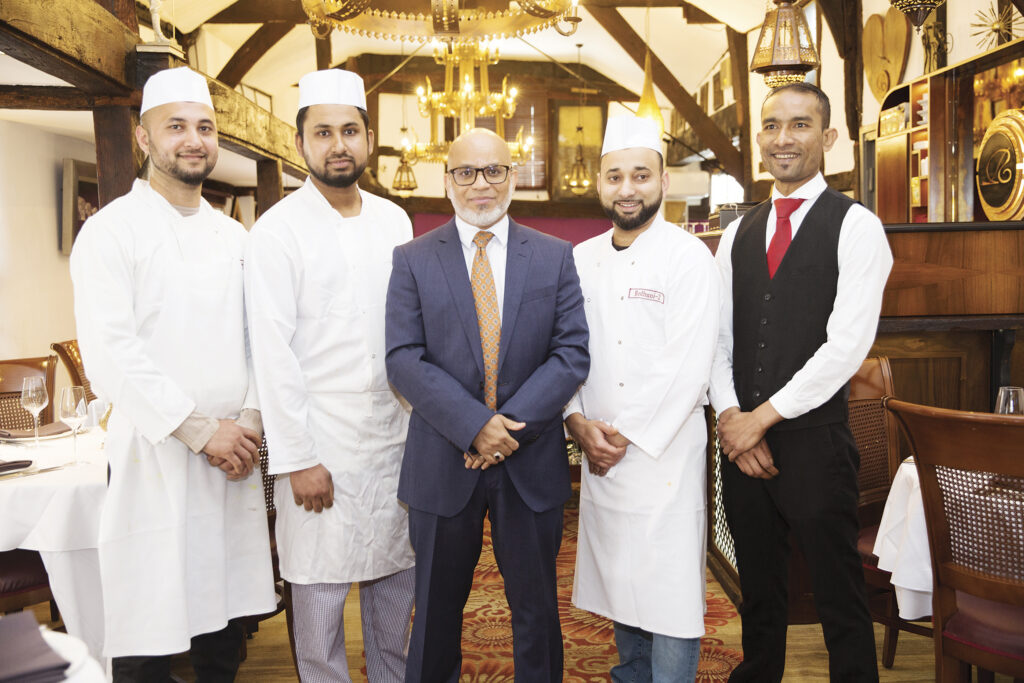
“I do a lot of research with my chef to make sure we come up with new dishes; every three to six months, we are creating something that we test along with our customers to make sure the flavours and the strengths of the spices are right,” says Miah.
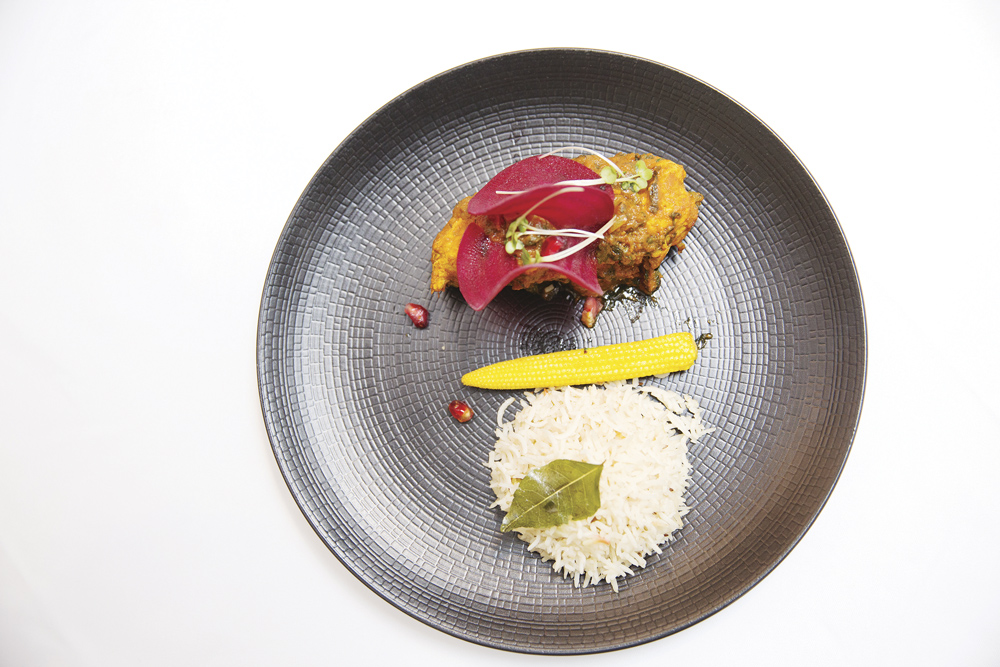
We sampled a few of the more popular dishes on our visit. Anarkali Chicken – a breast of chicken stuffed with spicy minced chicken and served with roasted chilli and onion sauce – one of the house specialties, was delicious – with just enough heat that lingered for some time, not taking away from any of the flavour. There is a lamb version too, while other must-try dishes include Shoo-Coo-Tee, a medium to spicy chicken curry from Goa and Beetroot Tikki – chicken cooked in sweet and sour sauce. The Paneer Lahori, featuring diced paneer with paprika spices and mixed peppers was a revelation too, bringing out the taste of paneer without being too overpowering.
Other popular dishes include Radhuni Chicken or Lamb, featuring the meat prepared with spinach and the chef’s own spices, cooked in the oven and a Tandoori starter of British lamb rack, marinated in spices and grilled in a clay oven. Much of the ingredients used in Radhuni’s cuisine are sourced locally, including the spices and meat but Miah points to how this has become increasingly expensive in the last year, a combination of the impact of Covid-19 and Brexit.
“Our takeaways kept us going but the price of spices increased and it was a challenge finding them at the right price this last year,” says Miah. “But we never compromised, we bought spices in smaller packets, even if this was more expensive. It was a struggle finding suppliers but we are getting there slowly. When prices increase but your costs are fixed, it’s a challenge.”
Embracing change
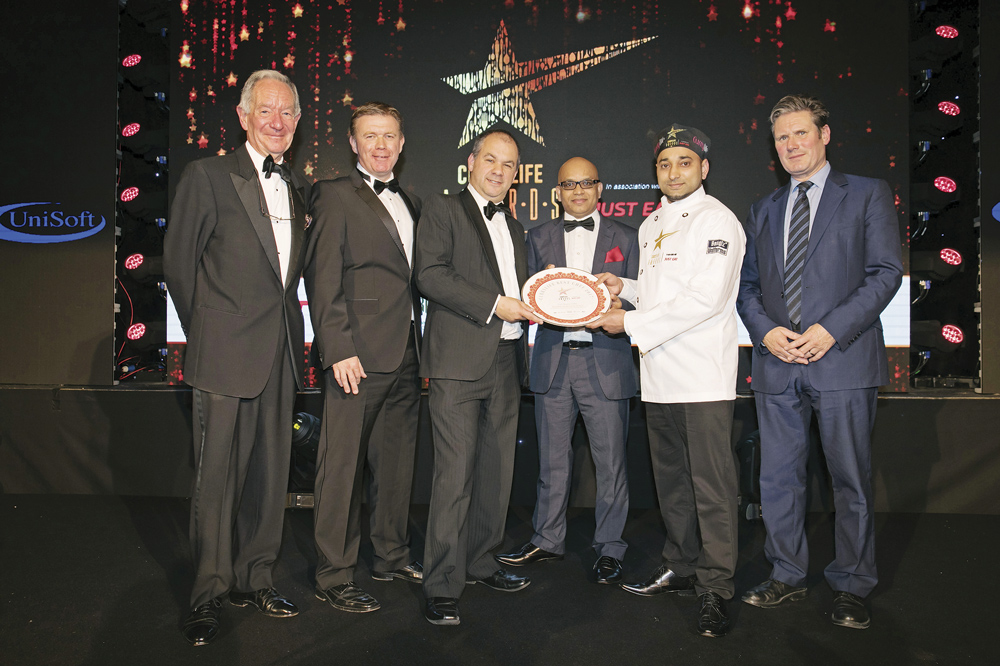
Being willing to adapt to change and not being afraid of taking a risk or two has never been more relevant than in the context of the last year, in light of the Covid-19 pandemic, and luckily it’s a philosophy that Miah has adopted over the years. Many restaurants have had to adapt to new ways of working in a very short space of time and for some, it has been too big a hurdle to overcome. Fortunately for Miah, being flexible has been his formula for success, although this approach hasn’t been without its challenges.
“In the last 14 years we have built up a solid reputation but we have also changed many aspects, from the menu to the interiors, this has been done to suit the customers and changing times,” he says. “We are lucky that underlining this, we have consistency from our staff, which helps to maintain order when you are making many changes. We had to furlough the front of house staff during the pandemic but I have managed to keep my existing kitchen staff, who have been with me for some time.”
With the restaurant remaining open throughout the various UK lockdowns, it made sense that all the chefs were kept on. In normal times, takeaways would account for around 30% of the business, compared to 70% for in-house dining. When the first lockdown occurred in March 2020, and with restaurants closing their doors to diners inside, Radhuni found the increasing demand for takeaways difficult to manage. Its menu is extensive, which could have created further challenges, but Miah chose to change the hours of operation rather than make the menu smaller. He also printed pocket-size fold-out versions of the menu for customers to take away, making it easier for them to keep the restaurant front of mind and to understand more about the many dishes on offer.
“As soon as the first lockdown was announced, the takeaway side went boom and we had to change our hours to cope with demand,” recalls Miah. “Lockdown happened so quickly that we didn’t have time to think, but we carried on with our normal menu and had to make changes to the kitchen instead. This involved opening an hour earlier (5pm instead of 6pm) and closing at 10pm instead of 11pm.”
One particular learning curve took place over New Year’s Eve in 2020. Miah recalls that the restaurant normally does around 100 takeaways during the entire evening – last year, this was the total achieved within one hour of opening time and by the end of the evening, there were close to 500 meals being ordered and prepared.
“This resulted in us changing our practices – as well as changing our hours, we made sure whatever could be prepared in advance was ready as much as possible for when we opened,” says Miah.
Grand designs
In keeping with his thinking of ‘not standing still’, and always looking at the business to see where changes can make a positive difference, Miah has ambitious plans, At a time when most businesses are taking stock of the impact of Covid-19 and tentatively reopening, Miah is looking to expand Radhuni, having acquired the empty premises next door, part of which was a former hairdresser’s. Renovations, which are due to be completed in September, will see the restaurant expand from 90 covers to 150, including the addition of a private dining area for up to 16 diners. The latter could be used for private celebrations as well as company gatherings.
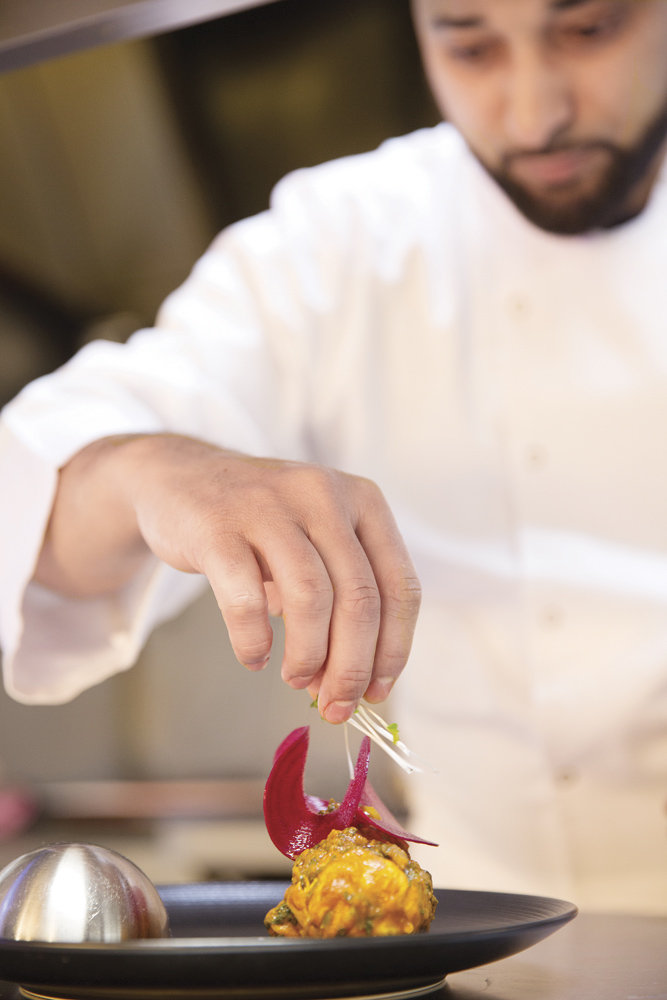
“The motivation to expand has come from our customers- we are so busy and we have been well supported throughout the pandemic with the takeaway side of the business,” says Miah. “The fact that we have been this busy – and that I have kept our six chefs on, and there have been very few changes in the kitchen, show that there is a demand for the business and that customers are coming back for more. We now have the opportunity to expand and while it is a difficult time for most restaurants, with many closing down, we are seizing this opportunity. We will provide more comfortable seating and we can have longer sittings between bookings, so our customers will not feel rushed and can instead enjoy their meals.”
There are also plans to add more modern touches to both the existing and new spaces, removing table cloths for example in favour of wooden tabletops, and also introducing a bigger lounge/bar area where people can relax with drinks before heading through to the dining area. Radhuni is also adding to its menu, offering lighter dishes for lunchtime, such as small Indian tapas-style plates, with the aim of attracting people who are keen to venture out more post-lockdown.
Team dynamics
Staffing is a topical issue in the hospitality industry, with many restaurants struggling to recruit employees as lockdown restrictions ease. With Radhuni having maintained its kitchen staff throughout the pandemic – and with many having been with the business for several years, Miah says he is lucky to have such a strong team around him. He says this consistency is reflected in the food and service and ultimately the customers’ satisfaction levels and whether they come back for more.
“Our kitchen staff remained the same and my chef has been with us for 13 years – I am finding though that front-of-house staff can be harder to find,” he says. And even after 32 years in the business, Miah is still very much hands-on, completing two shifts a day, in the morning and afternoon and visiting the other two sites on a regular basis.
“With 30-plus years in the business, it’s not just about working there or managing the business,” he says. “You have to be passionate and I am very hands-on – that way you get to see what is happening on a day-to-day basis and you can react, for example, by changing the menu to improve the quality. Our customers have changed many times over the years, so we need to reflect this with our offering, improving all the time and not standing still.”
Miah recalls that many years ago, one of his chefs told him that he was running too many places at the same time and that if he let other people take charge, that business would run better. He admits that he is a bit more relaxed now and while he may have done things differently from others who are now in charge at his other Radhuni branches, this may not necessarily have been for the better.
Miah is also aware of people’s changing perceptions towards food, with the current emphasis being very much on choosing healthier options that are more sustainable. While Miah believes this is important, offering choice is just as key, with Radhuni’s menu offering healthier dishes, specials and traditional curries. This will appeal to a broad range of customers. With the Indian restaurant industry incredibly competitive, and facing many challenges as it recovers post-Covid, Miah says it is important to stand out by improving your existing operation, or looking at doing something better or different. When the expansion is unveiled this September, he hopes to have achieved just that.
Radhuni Restaurant, The Old Library, Church St, Princes Risborough HP27 9AA
Read more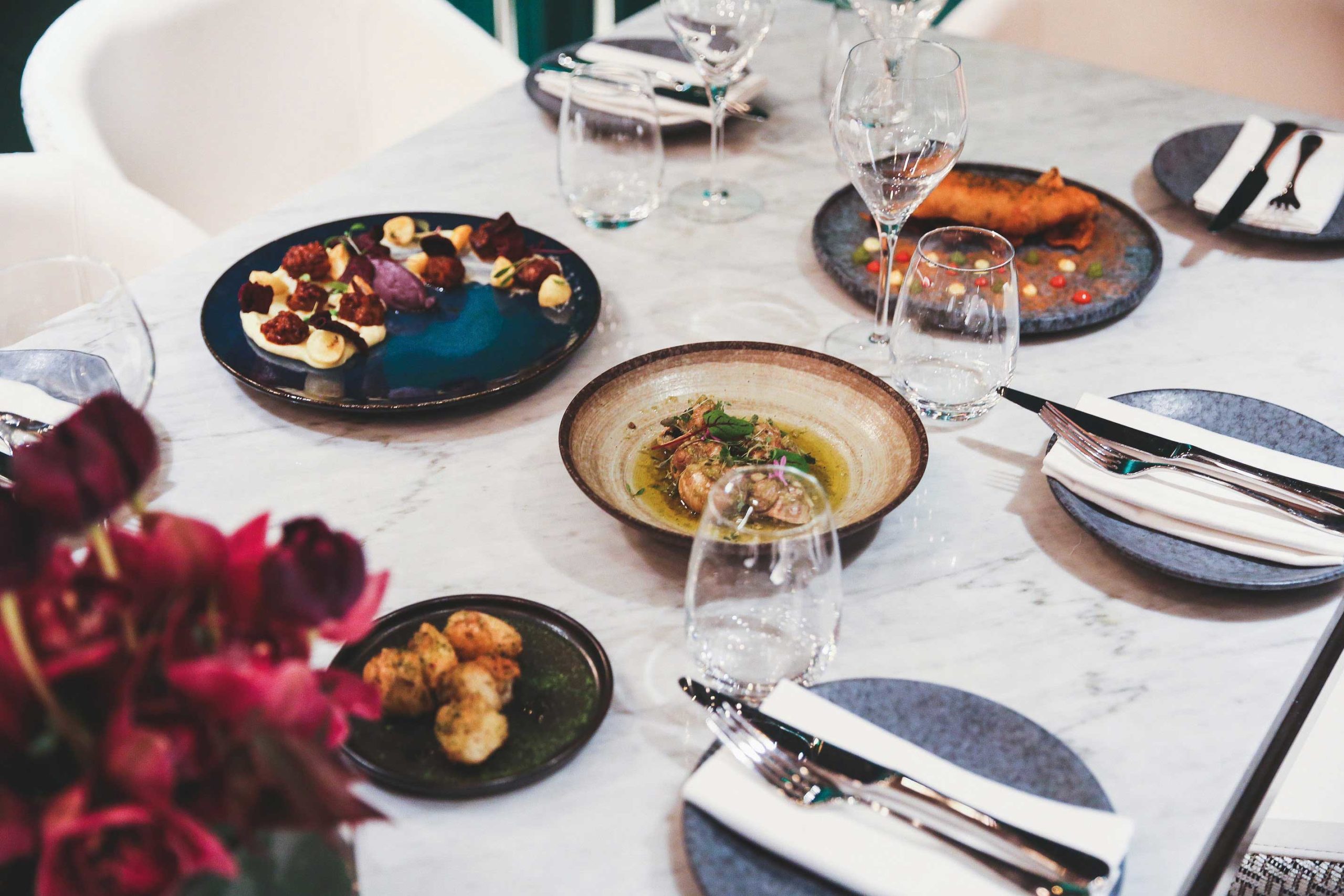
FAR-SIGHTED FARZI
Renowned Indian restaurateur Zorawar Kalra has gained a hard-won reputation for innovation and trendsetting in his homeland, with a penchant for offering unusual takes on traditional dishes.
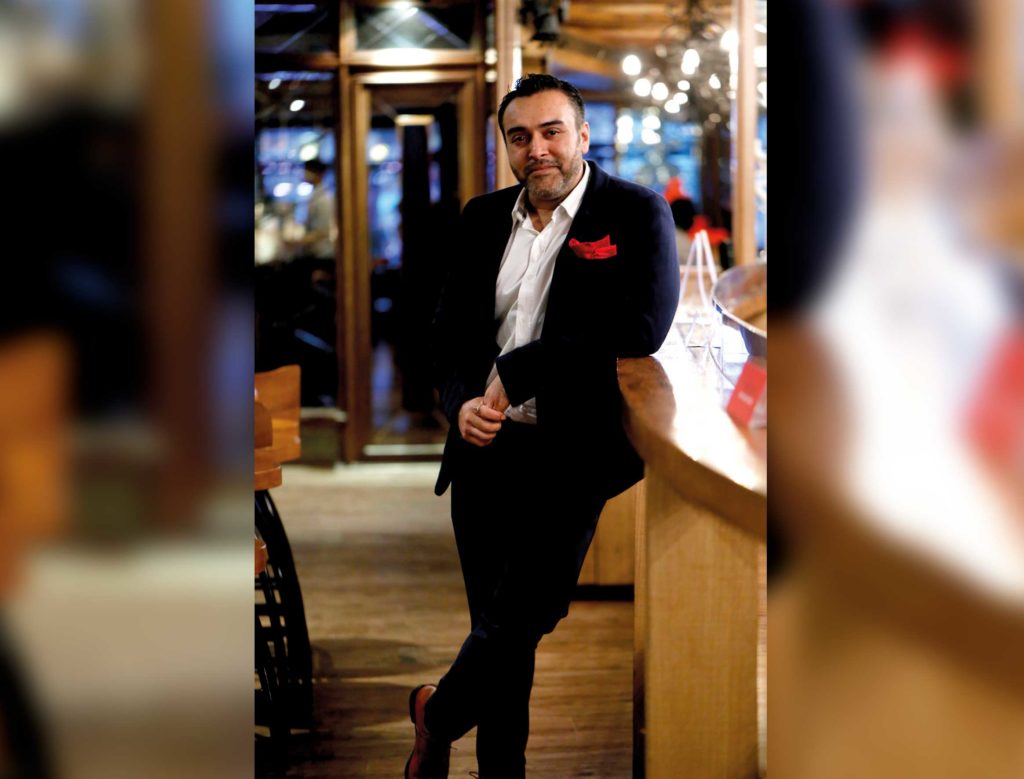
So when he announced the launch of his first London eatery, Farzi Cafe, promising local ‘twists’ on globally famous food, there was understandable fanfare around the opening.
Anticipation was further stoked by advanced publicity saying Kalra was especially pleased to be coming to London, because the city’s access to fresh and varied ingredients gave his chefs a ‘wonderful canvas’ on which to paint their menus.
So how did the reality live up to the hype when Curry Life visited the Haymarket restaurant in the heart of London’s West End?
First signs were promising as we scanned the menu, which was full of Asian takes on British classics.
There was a Masala Wagyu Beef Cottage Pie with purple mash potato and some Wagyu Beef scotch eggs, not to mention Amritsari halibut fish and chips – not with your standard mushy peas but a ‘chukki pea mash’.
There was also a generous helping of standard Indian dishes, such as various biryanis and tikkas, but again with a bit of a twist in each case. Hence there was a bok choy and asparagus biryani and a shitake and cottage cheese tikka.
We went for main courses, which tested the ‘traditional with a twist’ philosophy, so tried out the Jhol chicken biryani and a venison dish.
Both lived up to the something-slightly-different tag – the biryani nestling beneath a light pastry, a sort of upper crust biryani chicken pie, while the venison was an Irrachi pepper version.
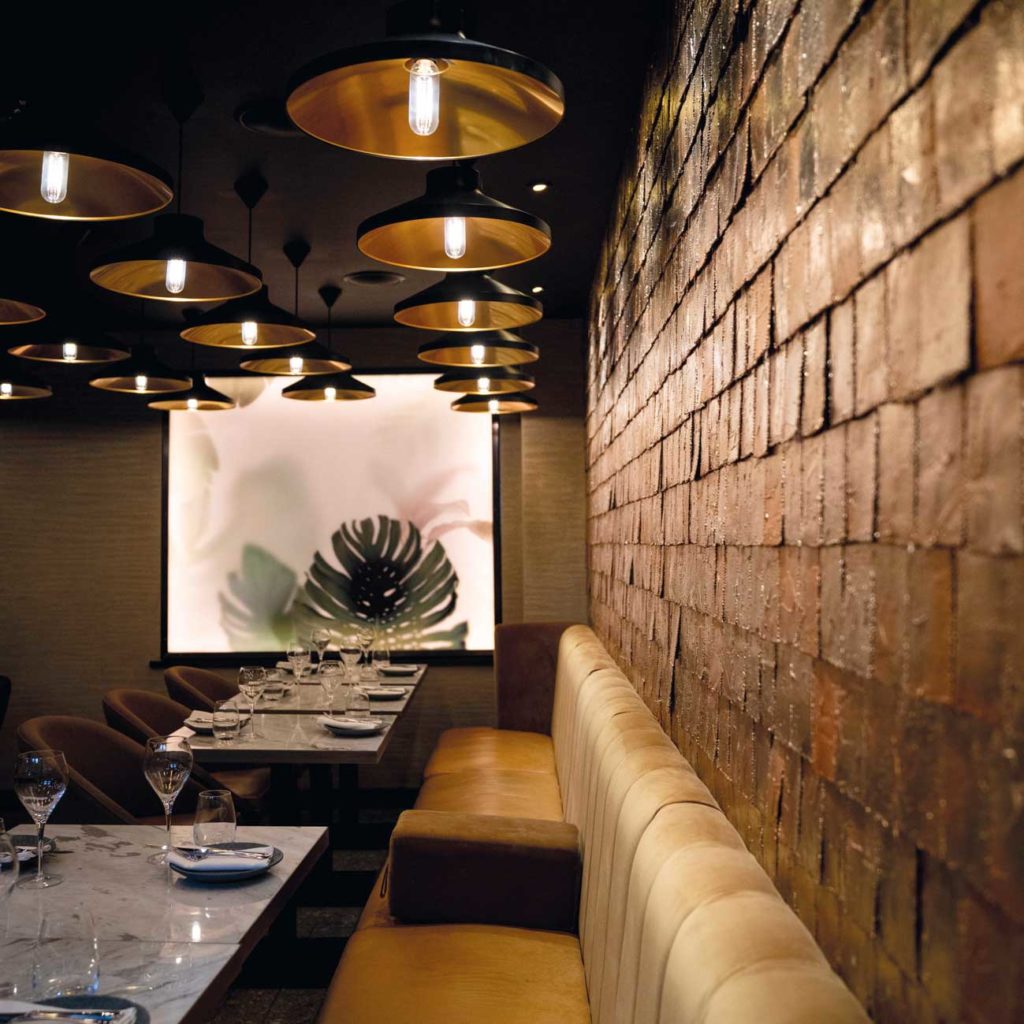
Whether it was the fresh authentic ingredients, or the skilful way they were put together and presented, both mains were scrumptious.
Not always easy meat to cook well, the venison was extremely tender, while the biryani was moist and well spiced.
The two mains were sandwiched between a selection of starters and desserts suggested by the attentive staffs that were serving us.
So the hors’douevres included grilled asparagus accompanied by toasted sesame seeds and chicken wings with a masala rub, as well as some tasty dal chawal arancini with nice achaar-papad chutney.
To finish off, we were plied with a Laddoo Shell which, when tapped, exploded with an outpouring of coconut mousse and berries – together with a Mango Semifreddo, which came with a coconut lime kheer, passion fruit foam and lychee – both absolutely delicious.
We resisted the temptation of accompanying the desserts with the ten-year old tawny port or sparkling wine, which is offered at a small extra cost, tempting though it was.
For diners who do enjoy a snorter or two with their meals, there is the type of extensive drinks menu you would expect at a high end West End bistro.
Prices were also generally what you would expect to pay for a smart restaurant in the heart of London – with our choice from the a la carte menu costing in the region of £40 a head including drinks– though there are also cheaper set menus.
There’s a two-course lunch and pre-theatre menu, which comes in at £20 a head, while the thee-course version costs £25.
Summing up, there’s probably something at Farzi Cafe to suit most tastes and pockets, living up to the ambitious goals set by its owner.
Suppose you could say – So Farzi, So good!
Farzi Cafe is at 8 Haymarket, London Sw1Y 4BP
Tel: 020 3981 0090 – www.farzilondon.com
Read more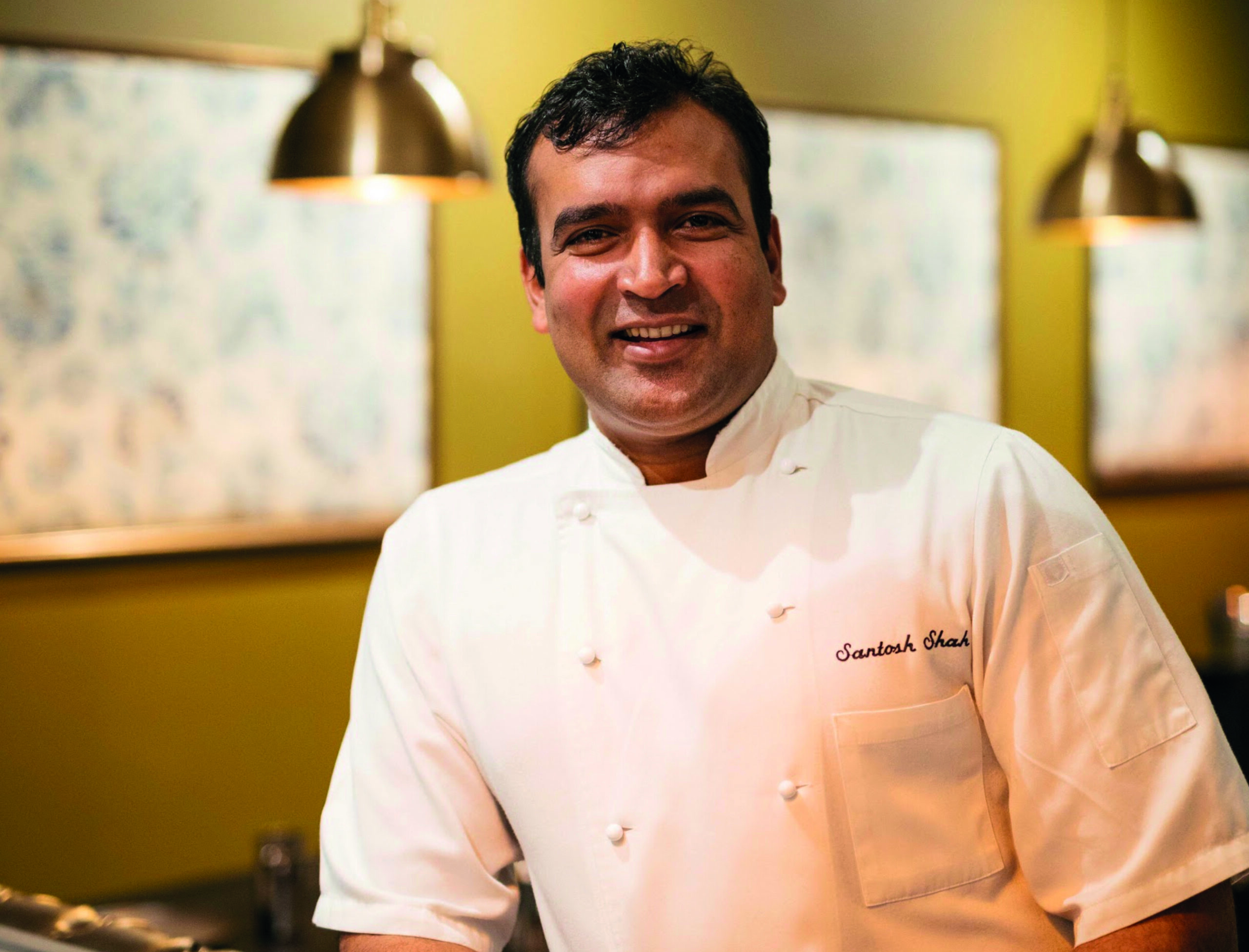
A view from Chef Santosh Shah
What inspired you to become a chef?
I spent my childhood in Nepal, moving to India when I was 14 or 15 years old. I started working as a kitchen porter and studied for a culinary diploma, gaining experience. I decided I wanted more international exposure, so I went abroad to Montenegro to work in a five-star hotel. I didn’t enjoy this however – it was not what I was expecting, but I stayed for one year to build up the work experience and enhance my CV, before moving back to India. I put everything to the test to keep learning and improving – whatever I learnt in one year in Montenegro, I experimented with when I returned to India. I then worked at a food festival which was featured in a newspaper, which led to a job in London.
How did your career develop?
When I first came to London, around 2010, I worked in a curry house, which wasn’t a great experience. I then worked at Dishoom, before moving to Michelin-starred Benares restaurant, which had a great work culture in the kitchen. Everyone was motivated, competitive and looking for new recipes, and I took all of this in. While at Benares, a colleague entered the Masterchef competition which sparked my interest, but they only lasted one round. This scared me so I prepared for the show for the next five years. I was at Benares for three years but I knew that I needed to refine my techniques and knowledge of French cuisine, which took me to Brasserie Blanc [Raymond Blanc’s restaurants], which was a great experience. I was then at Cinnamon Kitchen. Most recently, I was at the LaLit London hotel, but there were many management changes which didn’t create the best environment, so I returned to Cinnamon Kitchen.
What motivates you?
When I came to the UK, I really appreciated what it is to be a chef – in India at that time, there was no chef culture. I pushed myself, met different people and got support from mentors, particularly at Benares. I like to be inventive too – I was brave enough to cook and combine octopus with spices at The Cinnamon Club. I define myself as an innovative chef.
How have you been keeping busy during the various lockdowns?
I’ve had so much time to research food and look at new recipes. I’ve also been busy on social media and developing these channels. Lockdown has taught me how to make the most of my free time, and I’ve also been developing a cookbook.
What’s been the best advice you’ve received?
I have worked with Vivek Singh, executive chef of The Cinnamon Collection, the group of five restaurants which includes Cinnamon Kitchen, for a number of years. He told me to just be myself and you will find success in your life. There is no need to copy anyone – act like who you are, be how you are, be yourself and do what you love and what makes you happy.
What’s your biggest regret?
Not having been more passionate about world cuisine earlier on in my career. I tend to always focus on Nepalese/Indian cuisine – it wasn’t until I came to London that I focused on world cuisine. I should have done some research and practice when I was in India, but I am very proud of what I have achieved thus far.
Any tips for aspiring Masterchef contestants?
Just be yourself – it’s a lot tougher than what you see on television. The chefs I competed against were so strong but it was an amazing experience. Practice as much as you can!
What’s your favourite dish and how do you like to unwind?
I like to cook fish and lamb with smoky and chargrilled barbecue flavours. I’m a real fan of comfort food and prefer to have home cooked dishes, Nepalese-style. I like to watch movies in my spare time – particularly documentaries about chef and cooking shows.
What’s in the pipeline?
My ambition is to open a high-end Nepalese restaurant. We are talking to a range of investors but the plans are delayed slightly due to the Covid situation. We hope to be able to announce something by the end of this year or the middle of next year.
Read more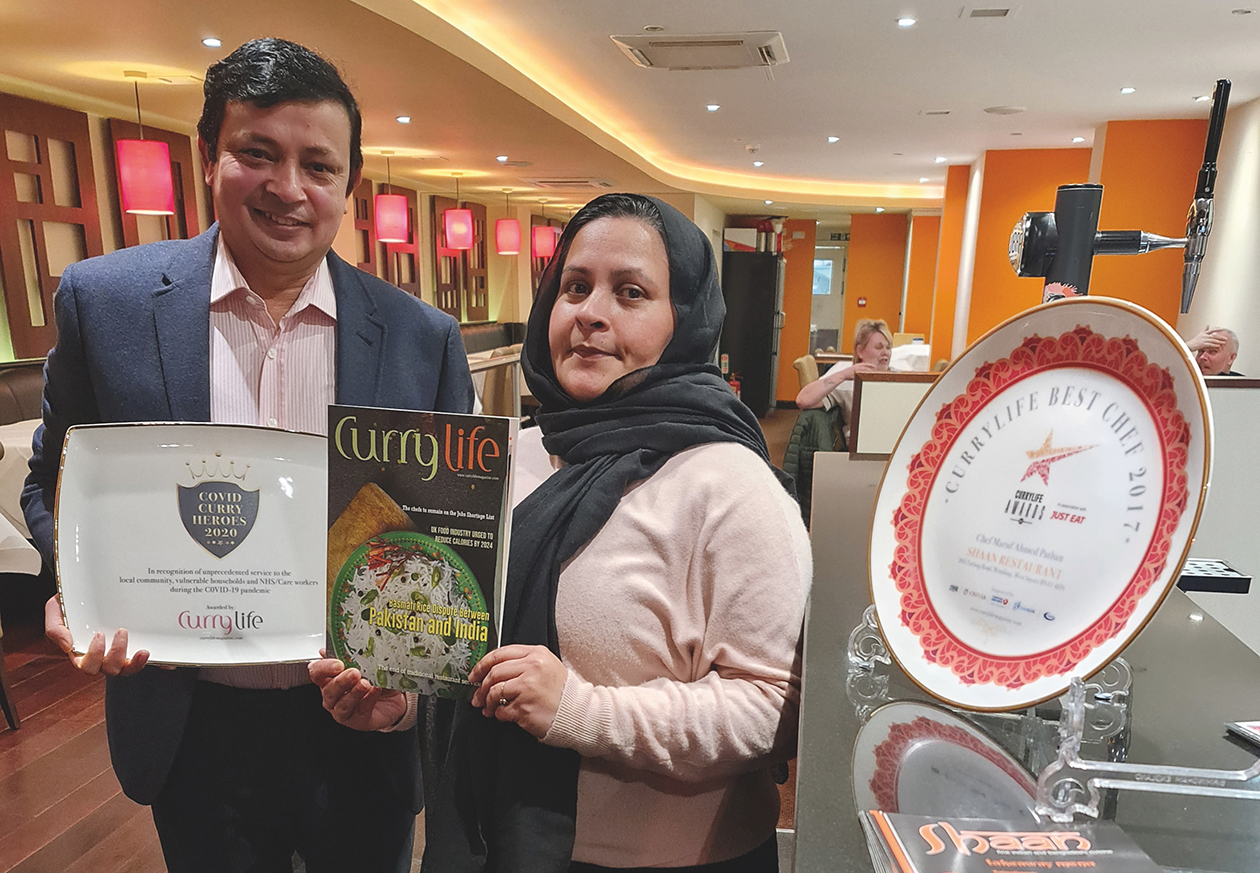
Shining Shaan
Russell Higham
Worthing, on the south coast, has often been seen as a poor relation to its bigger and brasher cousin, Brighton, a few miles to the east with its universities, nightlife and ‘party town’ reputation. Its smaller, more sedate neighbour, conversely, used to be known primarily for the elderliness of its population – the prevailing image of Worthing in many locals’ minds was a caricature of aged retirees hobbling gently along the town’s Victorian seafront esplanade. Over recent years, however, there has been a significant lowering of its citizens’ average age and Worthing now actually boasts a younger demographic than many of its West Sussex neighbours. This, along with Worthing’s perennial appeal as a British seaside holiday destination, has led to an improvement in the diversity and standard of its dining scene as the town’s increasingly youthful residents demand more modern and cosmopolitan cuisine.
Shaan, an 80-cover restaurant situated between two of Worthing’s main railway stations, has built up a loyal clientele from right across the age spectrum. Young millennial diners these days demand healthy cooking, sustainable ingredients and fast service whilst their older, more conservative customers want to eat their familiar favourite dishes in a comfortable environment served by staff who take the time to make them feel at home. Is it possible to keep both sides happy? Owner Shamim Ahmed and his wife Lima have proved that it is. This husband-and-wife team, who both hail originally from Sylhet in eastern Bangladesh, have combined their uniquely different skill sets to create, over the last ten years, a highly successful business that has defied, and even thrived under, the challenges presented by the global pandemic.
Being lockdown, the restaurant part of Shaan was closed to the public when I visited on a cold, wet, weekday evening in late January but I could see that deliveries were flying out of the door at an impressive rate. A socially distanced part of the main dining area, which is decorated in contemporary neutral tones featuring soft mood lighting and lots of natural materials, had been set aside for me in order to meet the strict Covid-19 regulations. From this vantage point, I could observe customers coming in to collect their takeaways, so I had the opportunity, as I waited for my own food, to ask some of them what made them keep coming back to Shaan. The same two answers were repeated by nearly everyone I asked: “flavour” and “service”.
The flavour element of Shaan’s appeal I discovered for myself immediately as a selection of starters were brought to my table: A Chicken Pakora with a subtly tangy honey and mustard dressing, a generously portioned King Prawn Butterfly and a Mixed Grill which included the most succulent and attractively hued Lamb and Chicken Tikka I’d had the pleasure of tasting in a long time. These were followed by an equally satisfying main course which comprised just about every single item on the menu. Everything looked and tasted perfect but particularly noteworthy were the plates that Shamim had told me are their regular customers’ favourites, including a tantalisingly good Bangladeshi deboned fish curry served with a hot and spicy sauce made from garlic, chillies, tomatoes and coriander, plus a medium-hot dish of wonderfully plump and juicy Chatga king prawns marinated in spices and cooked in a clay oven.
Lockdown had prevented supplies of their draught lager, Cobra, from being replenished by the supplier but there were ice-cold bottles of Bangla on hand as well as a small but well-stocked corner bar with wines and spirits to keep the dine-in customers lubricated when they are finally allowed back in. Once that happens and things return to normal, Shaan will return to employing four staff front-of-house plus five in the kitchen as well as three delivery drivers who have recently been supplemented by the Just Eat service which, Lima told me, currently represents around 25% of their takeaway business.
So how has Worthing’s changing demographic affected their business, I ask the couple. Shamim replies that “It’s now important to provide healthy, and not just tasty, food – especially to the younger generations. They spend more time at the gym than in the pub and take care about what goes into their bodies, so we offer plenty of vegetarian options and a gluten-free version of everything on the menu”. He adds that “They are also more concerned with the speed of service and can be less patient than our older diners.” Shamim concedes that this can cause misunderstandings sometimes when customers do not appreciate the time it takes to cook something really well but explains that he tries to avoid delays by ensuring staff have clearly defined stations which they take total responsibility for in order to prevent overlap and repetition of duties.
He also points out, interestingly, that “The difference between the ages is also very noticeable when it comes to drinking: ten years ago (when Shamim worked at another local Indian restaurant) we would occasionally have problems at the weekends with groups of young people consuming large amounts of alcohol before, during and after their dinner, getting loud and sometimes rowdy. Nowadays, they drink moderately with their meal because they’re so much more health conscious; they just pay the bill and leave quietly without any problems”.
As I enjoyed my post-dinner coffee, I had the opportunity to note Shamim and Lima’s relationship with their customers as they called in to collect their orders. It became apparent that many of them knew the owners by name and that Lima, in return, had made efforts to remember personal details about her customers and their families. One of these, a local nurse named Siobhan who had just finished working a twelve-hour shift, was stopping off on her way home to pick up an order of that ever-popular British favourite, Chicken Tikka Korma. She told me that Shaan is “without a doubt, THE place to go in Worthing” and, as I found when I checked a few reviews on Trip Advisor, this is a sentiment echoed by many of their customers. Siobhan went on to reveal that she would never touch curries before a friend took her to Shaan where she tried a Korma for the very first time. “I never used to like spicy food”, she laughs, “but since discovering Shaan, I’ve become so much more adventurous in my tastes…I even had a Jalfrezi the other day!”.
Siobhan is not the only nurse who has been enjoying the restaurant’s cooking. Shamim received a letter of thanks from his MP, Tim Loughton, for having generously provided Worthing Hospital with hundreds of free meals. He had contacted the hospital wanting to find a way of supporting NHS staff in their battle against Covid-19. Together, they came up with the idea of delivering up to 125 three-course meals in hygienic boxes each Thursday for a month during one of the worst periods of the pandemic last year. Needless to say, the deliveries went down a treat with the hardworking and hungry hospital staff. The local MP’s letter is proudly displayed in the restaurant along with his ’Covid Curry Hero’ award from Curry Life magazine in recognition of his good deeds. Not wanting to forget his roots, at the same time Shamim also paid and arranged for enough rice and meat to feed 500 people to be distributed to the poor of his native Sylhet back in Bangladesh. His altruistic giving seems to have brought him instant karma (or should that be korma!) too in the way of a doubling of his takeaway business: over the last year, Shaan’s average weekend trade has increased from around 25 to over 50 meals per night.
This success naturally makes Shamim and Lima Ahmed happy to be able to ensure continuity of employment for their staff and their families, many of whom are from the BAME community which has suffered disproportionately in the pandemic. Of course, it also makes the lucky residents of Worthing happy to have such an excellent source of fresh, flavoursome food right on their doorstep. After all, a good curry is something they can all appreciate, whatever their age.
Shaan Indian Cuisine
205 Tarring Road, Worthing
West Sussex BN11 4HN
T: 01903 209955 www.shaanindian.co.uk
Read more
Key measures for hospitality industry
Chancellor Rishi Sunak has outlined a series of initiatives to help the hospitality and leisure industry recover from the Covid-19 pandemic.
The main measures were announced as part of this year’s Budget on 3 March, with further help unveiled on 10 March.
The VAT cut of 5% for hospitality, tourism and leisure, down from the usual 20% rate and first introduced last July, has been extended for a further six months, until 30 September 2021. This will be followed by an interim rate of 12.5% until 31 March 2022, when it will then revert to the standard rate of 20%.
The Chancellor also announced an extension to the business rates holiday, until June 2021. After this, those companies that have been closed for business will be able to claim a two- thirds cut in rates, up to £2 million, with a lower threshold for those businesses that have been able to remain open.
Hospitality and leisure businesses can also apply for a ‘restart’ grant of up to £18,000, and the Government has also introduced a ‘Recovery Loan Scheme’, whereby businesses of any size can apply for loans from £25,000 up to £10 million through to the end of this year. The Government will guarantee these up to 80 per cent.
The furlough scheme has also been extended until September. Employees will continue to receive 80% of their hours that are not worked; businesses must contribute 10% of the cost towards this in July, rising to 20% in August and September.
On 10 March, the Government also announced an extension to the ban on commercial evictions for a further three months, until 30 June, providing some relief for those businesses that face mounting rent debt following lockdown. A ‘call for evidence’ has also been launched by the Government, to monitor discussions between landlords and tenants and to assess what steps should be taken beyond 30 June.
In response to the Budget, UKHospitality chief executive Kate Nicholls said: “The Chancellor has announced support to help our sector get back up and running, now it is vital that the Government sticks to its date of June 21st for a full reopening of the sector. Delay would see more businesses fail, more jobs lost and undo much of the good work the Chancellor has done to date.”
Read more
Immigration matters By Maria Fernandes

The pandemic and what it means for you
Last month, I discussed the new points based system which is likely to open up the labour market and will be of significant interest once the lockdown is over and life returns to the new normal. Of particular interest to the hospitality industry will be the return of Restaurant Managers and Hotel Managers. These positions and others will be examined in a future article. For now the main area of concern is the coronavirus pandemic and the impact of this on migrant labour issues. The Home Office have issued guidance in a number of areas which change regularly. The changes described below were updated on 06/01/2021.
Employers who have sponsor licences
• do not need to report student or employee absences related to coronavirus.
• do not need to report employees who are working from home due to coronavirus.
• Sponsored employees can be furloughed as their payments will not be considered as a “recourse to public funds”.
• If a Certificate of Sponsorship (CoS) has already been issued and the applicant has not applied for a visa because of the pandemic, it is still possible for them to apply for a visa even though the date on the CoS has passed. An explanation for the delay must be provided and supported with evidence where possible.
• If an employer is sponsoring a new employee and their visa application is pending they can start work before their visa application is decided if the sponsor assigned their CoS before 1 January 2021 or it is a Health and Care Visa. For CoS assigned after 1 January 2021, (with the exception of Health and Care visas) applicants must wait for the decision before starting work.
Right to work checks
The following temporary changes have been made to the right to work checks which, it should be noted, apply to all employers even if they do not have a sponsor licence. Sponsors will be aware that there are hefty penalties where checks are not properly carried out.
• checks can now be carried out over video calls where documents must be examined and notes retained
• job applicants and existing workers can send scanned documents or a photo of documents for checks using email or a mobile app, rather than sending originals
• Employers must use the Employer Checking Service if a prospective or existing employee cannot provide any of the accepted documents. Where there is a positive notification this protects the employer for 6 months.
Employers will be required to carry out a retrospective check within 8 weeks of the Covid-19 measures ending.
Overseas applicants
The Covid Visa Concession Scheme (CVCS) applies for those who are overseas and had a current visa when they left and are unable to return due to the pandemic. It covers those whose leave has expired or is about to expire before they can return to the UK. The other routes eligible for this concession are those where, if the person was in the UK with their previous leave, they would be able to apply for leave to remain.
It will allow a person to travel without a visa and on arrival will be granted 3 months leave outside the Immigration Rules (LOTR) on the same conditions as their previous grant of leave. This concession can only be used once. After returning to the UK, the person must submit their application in the normal way before the expiry of the 3 month period.
Break in continuous residence
The Immigration rules have a “continuous residence” requirement and a break in residence can adversely affect a person’s status. For example it could affect a person who has indefinite leave and cannot travel within the required 2 year period. Normally leave lapses under the regulations. The Home Office have clearly stated that “Absence from the UK as a result of a pandemic, such as Covid-19, will not count as a break in continuous residence.” It is important to retain any evidence of reasons for being unable to travel.
The Home Office have a coronavirus helpline [cih@homeoffice.gov.uk] which must be the first point of contact. The Home Office have emphasised throughout that the permission granted as a result of the pandemic is not leave to remain as such but a temporary solution. It is currently described as a grant of “exceptional assurance”. The legal position of this is unclear. For now, the concessions provide a way forward for employers and migrant employees.
Maria Fernandes
Fernandes Vaz Solicitors
87 Wembley Hill Road
Wembley
Ph: 02087330123
Email: info@fernandesvaz.com www.fernandesvaz.com
Read more


